Submitted:
01 September 2023
Posted:
06 September 2023
You are already at the latest version
Abstract
Keywords:
Introduction
- Development
1. The Great Myth of The Rouse Model: Its Failure to Describe the Rheology of Unentangled Melts (M < Mc)
1.1. (In) validation of the Rouse model Using dynamic data G’(ω), G”(ω)




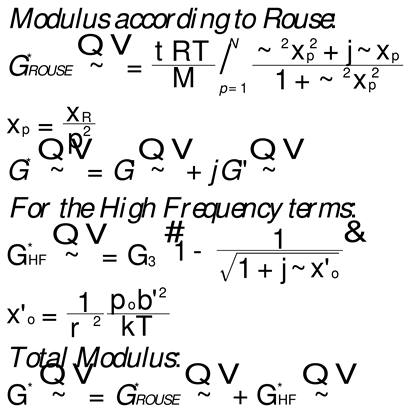
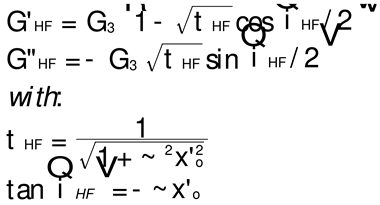
1.2. (In)validity of the Rouse Formula to Predict the Molecular Dependency of τR below Mc
1.2.1. Molecular Weight Dependence of the Rouse Time, τR from the M < Mc Majeste Data
1.2.2. Temperature Dependence of τR at M Constant
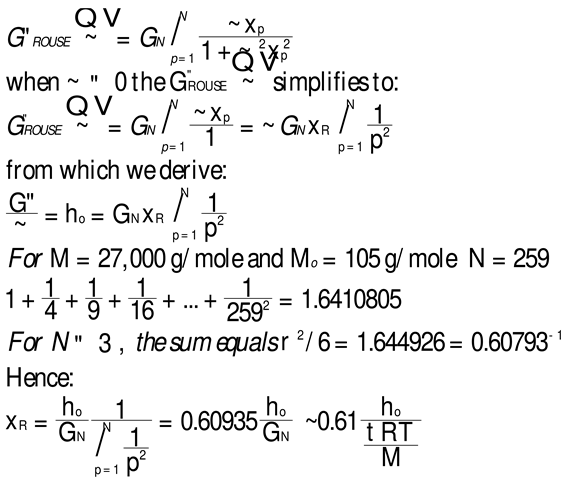
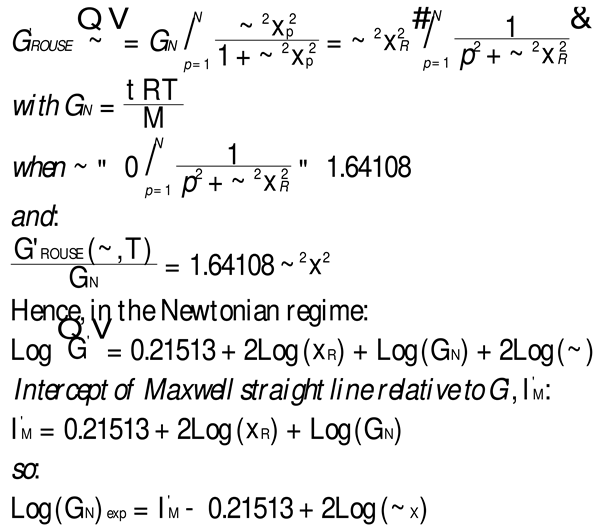
1.2.3. Comparing the Calculations of GN from the G’(ω) or G”(ω) Sides of the Rouse Equations and Invalidating the Rouse’s Approach
1.3. Conclusion Regarding the Myth of the Applicability of the Rouse Equation to the Rheology of Unentangled Polymer Melts
2. The Myth of the Extended Applicability of the Time-Temperature Superposition Principle
- -
- The superposition of curves by horizontal shifting on the log time or log frequency is a good approximation over a rather short temperature interval. There are 3 ranges of temperature within which the tts works well for polymer melts: the Tg to Tg+23±2 region, the Tg+23 to TLL region and the T > TLL region. For each temperature region a new set of WLF constants (or Vogel Fulcher constants) must be established. Superposition across regions is physically improper according to the Dual-Phase model [20}.
- -
- The use of bT pursuant to the normalization of the moduli by the Rouse modulus GN is incorrect. The reason has been implicitly given in the previous section which showed the inadequacy of using GN except for G”(ω) and thus viscosity (Figure 10). To find the correct value of bT, a double-shifting regression is always required [33]. It has been shown, for instance, that the vertical shift factor, log bT, when it is obtained by regression-double-shifting, is not as predicted by the Rouse modulus GN/GN1, yet that its variation with T permits to detect the presence of transitions, such as the transition at Tg+23 °C also visible from thermal stimulated depolarization data [19] or the TLL transition [24,35].
- -
- The temperature range of applicability of the tts varies with the strain imposed during the frequency sweeps ([2] “Effect of Strain” (sec. 5.8, p. 322) and with the thermal-mechanical history of the melt prior to the frequency sweep ([2] “Thermal-Mechanical History to create out-of-equilibrium melt properties”, sec. 4.3.5.2 p. 206).
- -
- The tts might be valid for a limited frequency range only or it might be valid on two or successive frequency ranges with different constants to express the 2 shift factors, Log aT and Log bT. It is the case for the 3 temperature ranges delimited by Tg+23 and TLL.

- -
- Why is the tts valid only for the low (left) frequency side of the peak of χ vs log ω?
- -
- Why does log η∗(ω)) vs log ω only needs one horizontal shift of the curves, Log aT, whereas the χ vs log ω requires two shift factors, Log aT and Log bT when applying the tts,
- -
- Why are we systematically correcting vertically the rheological moduli by (ρT)-1 without checking if the Rouse modulus GN does normalize both G’(ω) and G”(ω)?
- -
- Why is the value of χ at the maximum increase and not decrease as T increases? This appears counter-intuitive with the explanation that glassy relaxation components are causing the maximum in the χ vs log ω curve.
- -
- Why is the rheological behavior at T=115 oC different than at T=120 to 140 oC ?
3. The Great Myth of Reptation. the Failure of the Reptation Model to Correctly Describe and Understand the Shear-Thinning Behavior of Entangled Polymeric Melts (m > mc).
3.1. The Brilliance of the de Gennes’s Reptation Ideas
“…This result calls for a fundamental revision of the current theoretical picture for nonlinear rheological behavior of entangled polymeric liquids…the predictions by the tube model are not experimentally observed in a well-entangled polystyrene melt after a large uniaxial step deformation”.
3.2. Invalidation of Reptation by Rheo-SANS Results of Watanabe et al. (2007)
3.3. Invalidation of Reptation by Rheo-SANS Results of Noirez et al. (2009)
3.3. Invalidation of Reptation by Rheo-SANS Evidence that Chain Retraction does not Occur by Zhe Wang et al. [2017]
“the two prominent spectral features associated with the chain retraction—peak shift of the leading anisotropic spherical harmonic expansion coefficient and anisotropy inversion in the intermediate wave number (Q) range around Rouse time—were not experimentally observed in a well-entangled polystyrene melt after a large uniaxial step deformation”.
“Unlike the previous investigations, there is no ambiguity associated with model fitting and no room for human bias. Therefore, our critical test clearly demonstrates that the chain retraction hypothesis of the tube model is not supported by small-angle neutron scattering experiments.”
“This result calls for a fundamental revision of the current theoretical picture for nonlinear rheological behavior of entangled polymeric liquids.”
“Therefore, without an alternative mechanism for molecular relaxation, the idea of nonaffine deformation alone does not seem to be able to explain the experimental observation.”
“Since the tube theory is of paramount importance for our current understanding of the flow and deformation behavior of entangled polymers, the invalidation of the chain retraction hypothesis has immense ramifications.”
3.4. Conclusion on the Great Myth of the Applicability of the Reptation Model to Entangled Polymer Melts (M > Mc).
4. Shear-Refinement and Sustained Orientation: the Lack of Understanding by the Current Paradigm
4.1. Shear-Refinement
4.1.1. Pre-Treatment on Branched Polymers
“Thechange is seen to be reversible by solution treatment. Molecular weight characterization indicated that all these samples were identical… [Shear-refinement effects] “might at first appear to be the result of degrading the polymer, are frequently reversed by cooking the melt, though the time for which the melt may need to be cooked to achieve reversion may be much longer than the natural time of the material (viscosity/modulus at zero shear)”.
The pre-treatment of the LCB-PP in the capillary rheometer at the highest shear stress applied causes a significant reduction of the tensile stress, which can be referred to the reduction of the mass-averagemolar mass. However, the significant decrease of the extrudate swell after the pre-treatment cannot be explained by the change of the molar mass, as the elastic behavior of polymer melts is known to be independent of the mass-average molar mass. Therefore, the reduction of the extrudate swell is an indication of a change of the entanglement network during the pre-treatment.
4.2. Pre-Treatment on Linear Polymers
4.3. “Sustained Orientation”
4.4. The Munstedt’s Exclusive Requisite that the Polymer must be an LCB (with long Chain Branches) to be able to Obtain Shear-Refinement
4.4.1. Münstedt,’s Critical Condition that Branching must be Present to Observe Shear-Refinement is Wrong
5. Strain Induced Time Dependence of Rheological Functions
- Does a non-linear state obtained by increasing strain become immediately instable: time dependency starts as soon as its modulus differs from its linear value?
- Is the strain value for the end of linear viscoelasticity different from the strain value for the start of the time dependency of the non-linear modulus?
- Is the rate of the time dependency of modulus a function of the strain?
5.1. 1st Example of Strain Induced Transient of Viscosity (Inducement)
5.2. 2nd Example of Strain Induced Transient of Viscosity (Inducement and Recovery)
5.3. Conclusions on the Strain Induced Time Dependence of Rheological Variables
5.3.1. The “Process Engineer” Interpretation of the Results
5.3.2. The Theoretical Physicist Interpretation of the Results
Conclusion
| 1 | The data were kindly provided by Prof. Watanabe, who also clarified some of the experimental issues by email. |
References
- Staudinger H., “Makromoleculare Chemie und Biologie”, Bale, Wepf & Co, 1947.
- Ibar J.P., “The Physics of Polymer Interactions. A Novel Approach to Rheology and Processing”, Hanser Publishers, Munich (2019).
- Flory P.J. “SPATIAL CONFIGURATION OF MACROMOLECULAR CHAINS”, Nobel Lecture, December 11, 1974.
- de Gennes P.G.,”SOFT MATTER”, Nobel Lecture, December 9, 1991.
- Flory P.J., “Statistical Mechanics of chain molecules”, Interscience Press, New York, 308 (1969).
- de Gennes, P. G., “Scaling concepts in polymer physics”, Cornell University Press, 1979. [CrossRef]
- [Rouse P.E., “A theory of the linear viscoelastic properties of dilute solutions of coiling polymers”, J. Chem. Phys.21, 1272-1280 (1953). [CrossRef]
- [de Gennes,P. G., “Reptation of a Polymer Chain in the Presence of Fixed Obstacles”, J. Chem. Phys., 1971, 55, 572–579. [CrossRef]
- [4] Edwards, S. F., Doi, M., “The theory of polymer dynamics”, Clarendon, Oxford, 1986.
- Marrucci, G., “Dynamics of Entanglements: A nonlinear model consistent with the Cox-Merz rule”. J. Non-Newton. Fluid Mech., 1996, 62, 279-289. [CrossRef]
- Marrucci, G., Ianniruberto, G., “Interchain pressure effect in extensional flows of entangled polymer melts”, Macromolecules, 2004, 37, 3934-3942. [CrossRef]
- Wagner, M. H., Rubio, P., Bastian, H., “The molecular stress function model for polydisperse polymer melts with dissipative convective constraint release”, J. Rheol., 2001, 45, 1387-1412. [CrossRef]
- McLeish, T. C. B., Larson, R. G., “Molecular constitutive equations for a class of branched polymers: The pom-pom polymer”, J. Rheol.,1998, 42, 81-110. [CrossRef]
- Ibar, J. P. The Great Myths of Polymer Melt Rheology, Part I: Comparison of Experiment and Current Theory. J. Macromol. Sci., Part B, Phys., 2009, 48, 1143-1189. [CrossRef]
- Ibar, J. P., “The Great Myths of Rheology, Part II: Transient and Steady-State Melt Deformation: The Question of Melt Entanglement Stability”, J. Macromol. Sci., Part B, Phys., 2010, 49, 1148-1258.
- Ibar, JP. “Rebuttal to JOR paper Mechanical Pre-treatments of Polymer Melts by Helmut Munstedt”, GJSFR_A_Vol22_Issue5_pp21_31(2022).
- Ibar J.P., “Trouble with Polymer Physics: Development of “Sustained Orientation” Contradicts the Current Understanding of the Liquid State of Polymers”, Journal of Macromolecular Science, Part B, 54:6, 722-748, (2015). [CrossRef]
- Ibar J.P., “Shear-Thinning of Polymeric Melts: the Failure of the Reptation Model”, Chapter 7 of Ref. 2.
- Ibar, J. P., “Do we need a new theory in polymer physics?”, J. Macromol. Sci., Part C: Polym. Rev. 37, 389-458. (1997). [CrossRef]
- Ibar J.P., “A Dual and Cross-Dual interpretation of interactive coupling of conformers applied to thermally activated polarization and depolarization of polymers” in Part I Chapter 3 of “Dual-Phase Depolarization Analysis. Interactive Coupling in the Amorphous State of Polymers”, De GRUYTER Publisher, Berlin, REFERENCE, 2021.
- Ibar J.P., “ The Dual-Phase Model of Polymer Interactions and the Cross-Dual-Phase Model of Entanglements“ in Chapter I.4 of “Dual-Phase Rheology”, De GRUYTER Publisher, Berlin (projected 2024).
- Ibar J.P., “ Grain-Field Statistics of Open Dissipative Systems. Application to Polymer Conformers in Interactions”., (in preparation), DE GRUYTER Publisher.
- Matsumiya Y., Watanabe H., “NonLinear Elongational Rheology of Unentangled Polystyrene and Poly(p-tert-butylstyrene) Melts’, Macromolecules, 51,9710-9729 (2018). [CrossRef]
- Majeste J-C, “Propriétés viscoélastiques de polymères linéaires à très large distribution de masses molaires », PhD Thesis (Physique), Université de Pau et Pays de l’Adour, 1998.
- Ibar J.P., « A Dual-Phase Approach to reveal the presence and the impact of the TLL transition in Polymer Melts. Part I: Predicting the existence of Boyer’s TLL transition from the Vogel-Fulcher equation”, J. Macromol.Sci. B.Physics, 60(10),727-791 (2021).
- Montfort J P, “DYNAMIQUE MOLECULAIRE ET COMPORTEMENT RHEOLOGIQUE DES POLYMERS ENCHEVETRES EN PHASE FONDUE ET EN SOLUTION CONCENTREE », p. 75, Docteur d’Etat (Science), Université de Pau et Pays de l’Adour, 1984.
- Williams M.L, Landel R.F, Ferry J.D, “The temperature dependence of relaxation mechanisms in amorphous polymers and other glass-forming liquids.”, J. Am. Chem. Soc. 77, 3701 (1955). [CrossRef]
- Ibar, J. P. The Great Myths of Rheology Part III: Elasticity of the Network of Entanglements. J. Macromol. Sci., Part B, Phys., 2013, 52, 223-309. [CrossRef]
- Gray R.W., Harrison G., Lamb J., Proc. Roy. Soc. London, A 356, 77 (1977).
- Davidson D.W., Cole R.H., J. Chem. Phys.,9, 341 (1951).
- Benallal A., Marin G., Montfort, J.P., Derail C., Macromolecules, 26, 7229 (1993).
- Leonardi F., “Determination de la distribution des masses molaires d’homopolymeres lineaaires par spectroscopie mecanique », Table III-1 p. 146, PhD Thesis (Physique), Universite de Pau et Pays de l’Adour, 1999.
- Ferry J.D, « Viscoelastic Properties of Polymers », John Wiley & Sons, Ch. 11 (1970).
- Ibar J.P., ”Non-Newtonian Flow Behavior of Amorphous Polymers in the T > Tg Temperature Range: A New Analysis of the Data According to the “Double-Shift” Procedure”, J. Macromol. Sci. Phys.,B19(2),269-308 (1981).
- bar J.P., Chapter 5 of Ref. 2, Figs. 5.43 to 5.47 pp. 307-311.
- Ibar J.P., « A Dual-Phase Approach to reveal the presence and the impact of the TLL transition in Polymer Melts. Part II: The theoretical and practical relevance of the TLL existence and characteristics on the understanding of the melt thermal analysis and rheological properties of polymers: Duality and Cross-Duality of the interactions” J. Macromol.Sci. B.Physics, 60(10),792-838 (2021).
- M. Doi, Molecular Rheology of Concentrated Polymer Systems. I, J. Polym. Sci., Polym. Phys. Ed. 18, 1005 (1980). [CrossRef]
- S. T. Milner and T. C. B. McLeish, Reptation and Contour Length Fluctuations in Melts of Linear Polymers, Phys. Rev. Lett. 81, 725 (1998). [CrossRef]
- E. Likhtman and T. C. B. McLeish, Quantitative Theory for Linear Dynamics of Linear Entangled Polymers, Macromolecules 35, 6332 (2002). [CrossRef]
- M. Daoud and P. G. de Gennes, Some Remarks on the Dynamics of Polymer Melts, J. Polym. Sci., Polym. Phys.Ed. 17, 1971 (1979). [CrossRef]
- J. Klein, Dynamics of Entangled Linear, Branched, and Cyclic Polymers, Macromolecules 19, 105 (1986). [CrossRef]
- G. Marrucci, Dynamics of Entanglements: A Nonlinear Model Consistent with the Cox-Merz Rule, J. NonNewtonian Fluid Mech. 62, 279 (1996). [CrossRef]
- D. W. Mead, R. G. Larson, and M. Doi, A Molecular Theory for Fast Flows of Entangled Polymers, Macromolecules 31, 7895 (1998). [CrossRef]
- S. T. Milner, T. C. B. McLeish, and A. E. Likhtman, Reptation and Contour-Length Fluctuations in Melts of Linear Polymers, J. Rheol. 45, 539 (2001). [CrossRef]
- G. Marrucci and N. Grizzuti, Fast Flows of Concentrated Polymers—Predictions of the Tube Model on Chain Stretching, Gazz. Chim. Ital. 118, 179 (1988).
- D. Pearson, E. Herbolzheimer, N. Grizzuti, and G. Marrucci, Transient Behavior of Entangled Polymers at High Shear Rates, J. Polym. Sci. B 29, 1589 (1991). [CrossRef]
- R. G. Graham, A. E. Likhtman, T. C. B. McLeish, and S. T.Milner, Microscopic Theory of Linear, Entangled Polymer Chains under Rapid Deformation Including Chain Stretch and Convective Constraint Release, J. Rheol. 47, 1171 (2003). [CrossRef]
- M. Doi and S. F. Edwards, Dynamics of Concentrated Polymer Systems Part 2.—Molecular Motion under Flow, J. Chem. Soc., Faraday Trans. 2 74, 1802 (1978). [CrossRef]
- R. G. Larson, “Constitutive Equations for Polymer Melts and Solutions” (Butterworth-Heinemann, Oxford, 2013).
- Watanabe, H., Kanaya, T., Takahashi, Y., “Rheo-SANS behavior of Entangled Polymer Chains with Local Label Under Fast Shear Flow”. Activity Report on Neutron Scattering Research: Experimental Reports 14 (2007) Report Number: 146.
- Noirez, L., Mendil-Jakani, H., Baroni, P., “New light on old wisdoms on molten polymers: Conformation, slippage and shear banding in sheared entangled and unentangled melts”. Macromol. Rapid Commun. (2009) 30, pp. 1709–1714.
- Wang, Z., Lam, C.N., Chen, W.-R., Wang, W., Liu, J., Liu, Y., Porcar, L., Stanley, C.B., Zhao, Z., Hong, K., Wang, Y., “Fingerprinting Molecular Relaxation in Deformed Polymers”.,Phys. Rev. X (2017) 031003. [CrossRef]
- Cogswell, F.N., “Polymer Melt Rheology, a Guide for Industrial Practice”, Woodhead Publishing Ltd., p. 57 (1997).
- D.E. Hanson, Polym. Eng. & Sci., 9, (6), 405-414 (1969) “Shear Modification of Polyethylene”.
- M. Rokudai, J. Appl. Polym. Sci., 23(2), 463-471 (1979) “Influence of shearing history on the rheological properties and processability of branched polymers”. Also.
- M. Rokudai, S. Mihara, and T. Fujiki., J.Appl. Polym. Sci., 23:3289, 1979, “Influence of shearing history on the rheological properties and processability of branched polymers.”. [CrossRef]
- B. Maxwell, “Controlled Shear Modification of Low Density Polyethylene”, paper presented at the 50th Anniversary Conference of the Society of Rheology, Boston (1979)].
- J.F. Agassant, P. Avenas, J-P. Sergent, B. Vergnes, and M. Vincent. La mise en forme des matières plastiques. Lavoisier Tec et Doc, 1996.
- H. P. Schreiber. Polym. Eng. Sci., pages 317–323, October 1966, ”Cause and effect in time dependent flow of thermoplastics melts -a review”.
- G. Ritzau. Shear modification of polyolefins and its integration on polymer processing. Int.Polymer Process., 1(4):188–197, 1987. [CrossRef]
- G. Ritzau, A. Ram, and L. Izrailov. Effect of shear modification on the rheological behaviour of two LDPE grades. Polym. Eng. Sci., 29(4):214, 1989.
- P. J. R. Leblans and C. Bastiaansen, Macromolecules, 22(8):3312–3317, 1989. “Shear modification of low density polyethylene: its origin and its effect on the basic rheological functions of the melt”. [CrossRef]
- M. Van Prooyen, T. Bremner, and A. Rudin. Polym. Eng. Sci, 34(7):570–579, mid-April 1994.”Mechanism of shear modification of low density polyethylene”. [CrossRef]
- H. Münstedt. Colloid Polim. Sci., 259:966–972, 1981, “The influence of various deformation histories on elongational properties of LDPE”.
- Ram and L. Izailov. J. Appl. Polym. Sci., 31:85–100, 1986. « Shear modification of polyethylene”.
- S. Bourrigaud, “Etude de la modification des propriétés rhéologiques induite par l’écoulement : application à l’extrusion-couchage », PhD, Universite de Pau et Pays de l’Adour (2004).
- S. Berger,”Einfluss der Mechanischen Vorgeschichte aud das rheologische Verhalten von Langkettenierzweigtem Polypropylen”, PhD Thesis, University of Erlanden (2005).
- S. Bourrigaud, G. Marin and A. Poitou, Macromolecules ,36, 1388-1394 (2003), “Shear-Modification of Long-Chain branched Polymers: A Theoretical Approach using the Pom-Pom Model”. [CrossRef]
- J. Stange, S.Berger and H. Munsted, ESR AERC Grenoble (2005), “ Influence of flow history in the rheological properties of a long-chain branched Polypropylene”.
- Ibar, J.P.,” Extrusion of Polymer Melts under Intensive Shear-Thinning Inducing Lower Pressure and Temperature Requirements”. ANTEC Proceedings (2001), paper 481.
- Ibar, J.P., “Control of Pseudo-Plasticity of Polymer Melts by Disentanglement Methods”. Proceedings Society European Rheology SER (2005) Grenoble. Also: Ibar, J.P.,” Control of Thixotropicity of Polymer Melts by Disentanglement Processing”. ANTEC Proceedings (2005) paper 10370.
- Ibar, J.P.,” Process for the Control of Flow Properties of Polymers”. US2005/0267289A1 (2005).
- Ibar, J.P., “Flow Simulation for Polymer Melt under Disentanglement Conditions”. ANTEC Proceedings (2004) paper 1071.
- Apitchi, A.L., Ortat, J.V., Ibar, J.P., Bull. Am. Phys. Soc. (1997) 42(1), p. 106.
- Ibar, J.P., “Control of Viscosity of Polymer Melts Prior to Molding by Disentanglement Methods”. ANTEC Proceedings (1999) paper 226.
- Ibar, J.P., “Time Dependence of Shear-Thinning of Polymer Melts”. ANTEC Proceedings (2001) paper 480.
- Ibar, J.P., “Reduction of Viscosity of Polymer Melt by Shear-Thinning and Disentanglement: Rheological Criteria and Commercial Perspectives”. ANTEC Proceedings (2001) paper 482.
- Ibar, J.P., “Disentanglement of Polymer Melts”. ANTEC Proceedings (2004) paper 579.
- Ibar, J.P., “Disentanglement of Polymer Melt to Produce Lower Viscosity Melts and Higher MFI for their Pellets upon Subsequent Processing”. Proceedings of APS Division of Polymer Physics (2004) N29-010, Abstract 22112, Montreal, March 22–26.
- Ibar, J.P., “Disentanglement of Polymer Melts Using a Lab Dynamic Rheometer”. Proceedings of APS Division of Polymer Physics (2004) N29-017, Abstract 218110, Montreal, March 22–26.
- Ibar, J.P., “Characterization of Polymer Resins Produced by Melt Disentanglement”. Proceedings Society European Rheology SER (2005) Grenoble.
- Ibar, J.P., “Time Dependence of Viscosity of Polymer Melts”. Proceedings Society European Rheology SER (2005) Grenoble.
- Ibar, J.P., Hicks, T., Morneau, S., “PET/PC, PC/PC Properties from Disentanglement Processing”. Proceedings SPE (2005) paper 101117.
- Ibar, J.P., “PC Flow and Mechanical Performance from Disentanglement Processing”. ANTEC Proceedings (2005) paper 101381.
- Ibar, J.P., “Method and Apparatus to control Viscosity of Molten Plastics prior to a Molding Operation”. US Patent 6,210,030 (2001).
- Ibar, J.P., “Viscosity Control for Molten Plastics Prior to Molding”. US Patent 5,885,495 (1999).
- Ibar, J.P., Bull. Am. Phys. Soc. (1997) 42(1), p. 283.
- Munstedt H., ““Mechanical pretreatment of polymer melts: Critical aspects and new rheological investigations on a linear and a long-chain branched polypropylene”, J.O.R., 65.5(2021):871-885. [CrossRef]
- McLeish, T.C.B., Larson, R.G., J. Rheol. (1998) 42, p. 81.
- Ref.2 sec. 4.4.2 “Challenging Interpretations”: 4.4.2.1 “Viscous Heating”, 4.4.2.2 “Shear Degradation”, 4.4.2.3 “Drooling of the Melt outside the Rheometer Plates”, 4.4.2.4 “Plastification Due to the Monomer Concentration Increase by the Shear Stress”, 4.4.2.5 “Shear-Thinning”, 4.4.2.6 “Edge Fracture Explanation”, 4.4.2.6.1 “Melt Fracture Initiation: Vinogradov’s Criteria”, 4.4.2.6.2 “Simultaneous Dielectric and Dynamic Mechanical Measurements in the Molten State”, 4.4.2.6.3 “Effect of the Nature of the Surface Melt Contact”.
- Vinogradov, G.V., Malkin, A.Ya., Plotaikova, E.P., Kargin, V.A., Dokl. Akad. Nauk. (1964) 154, p. 1421.
- Wang, S.-Q., Adv. Polym. Sci. (1999) 138, pp. 227–275.
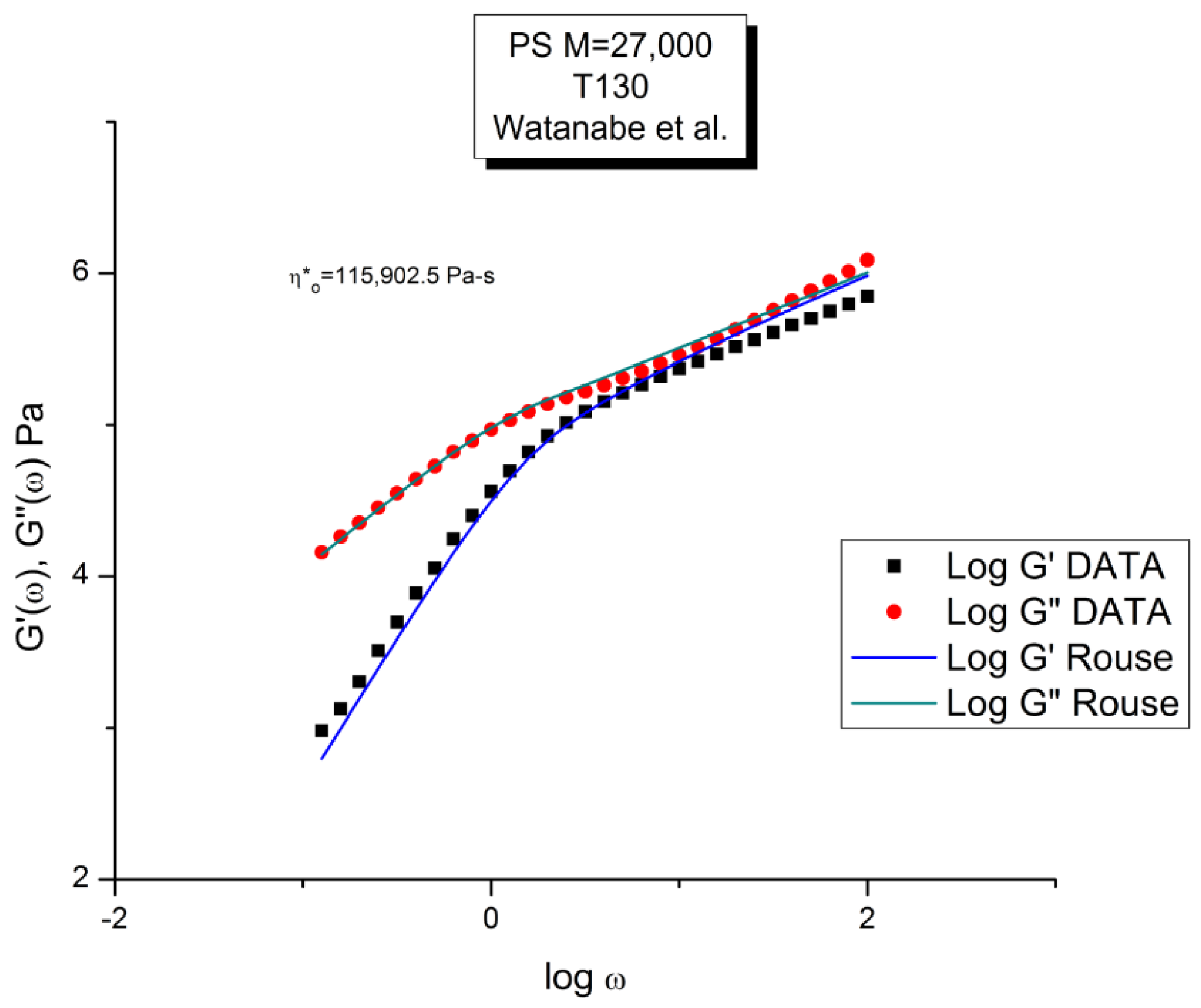
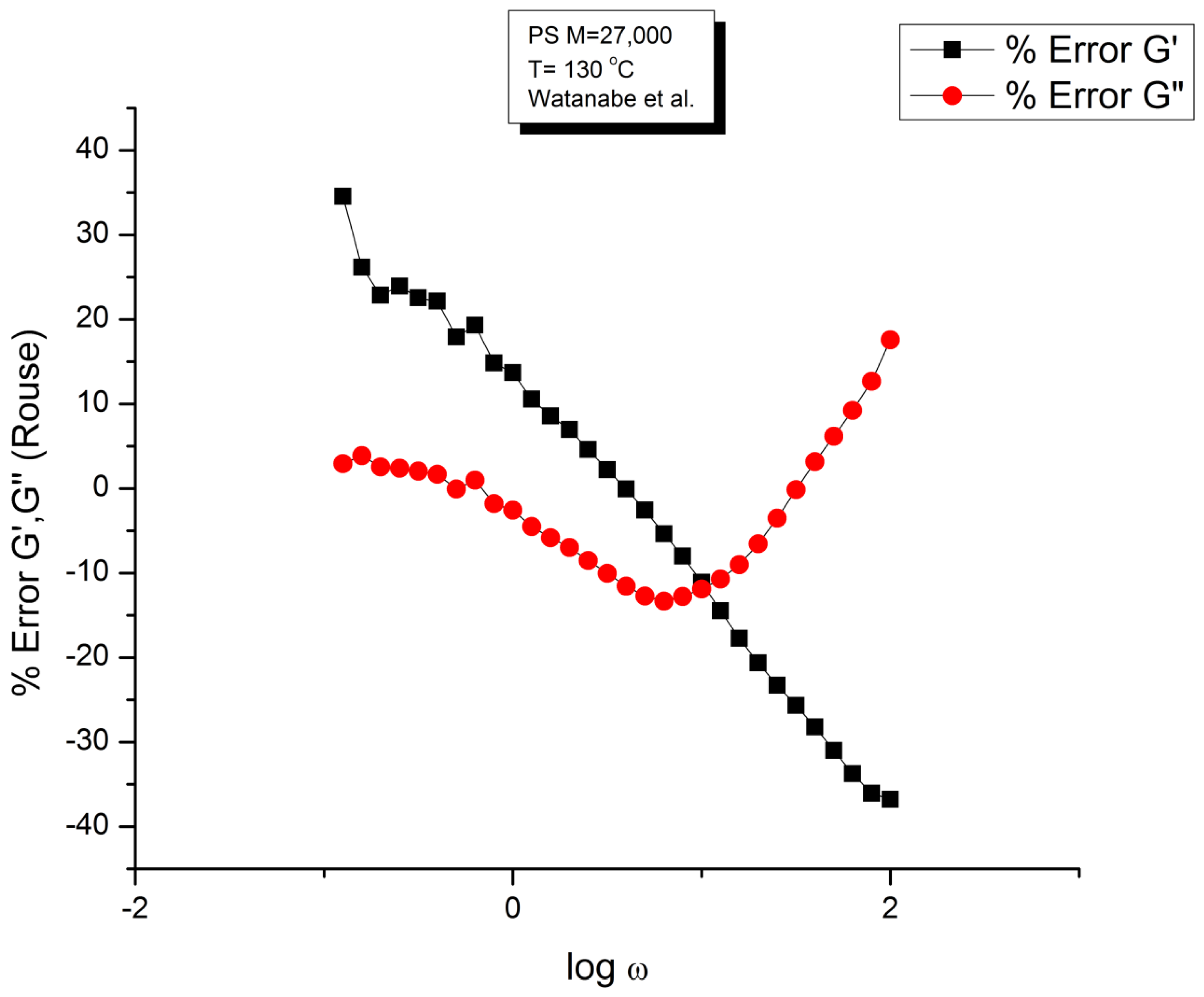
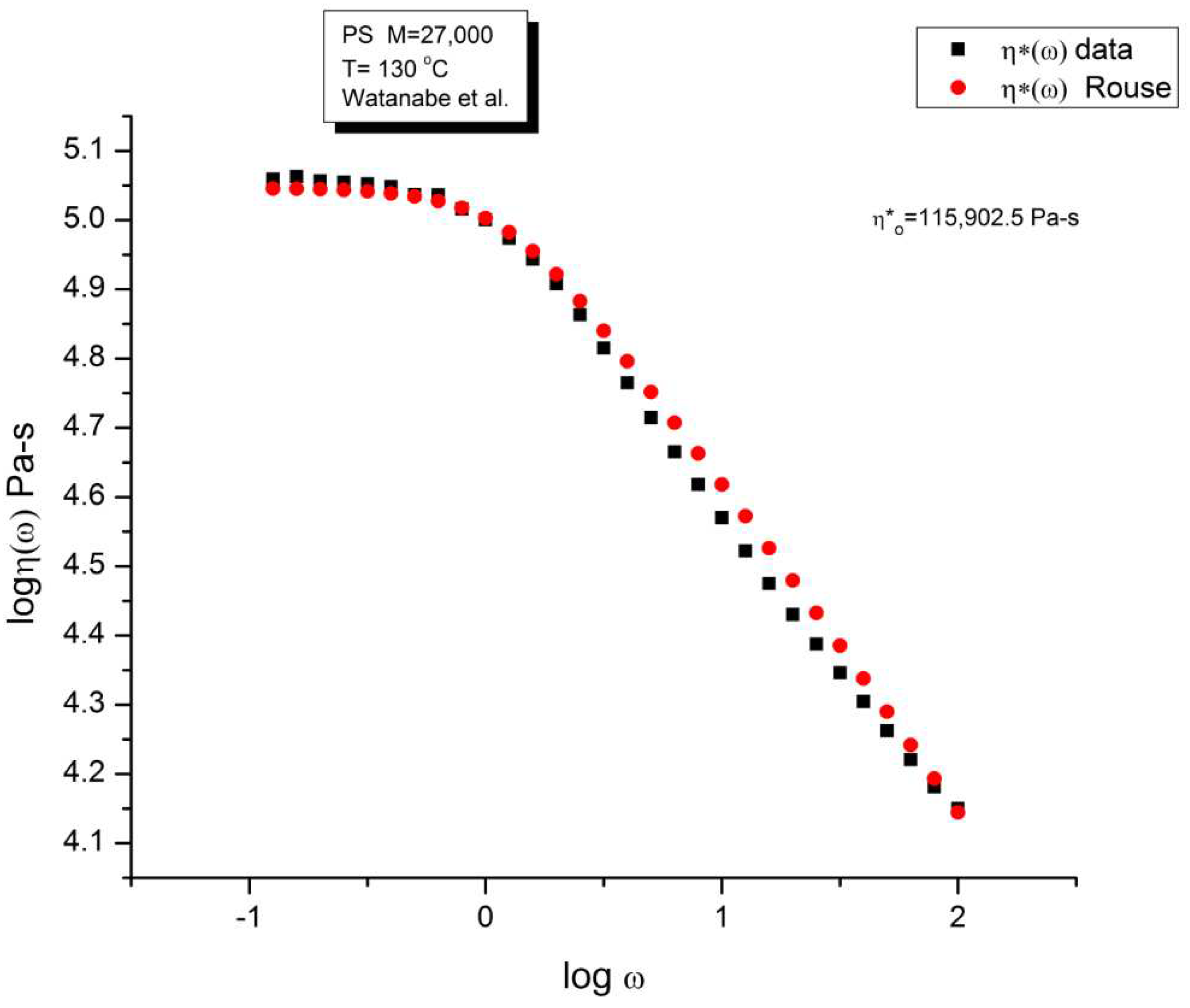
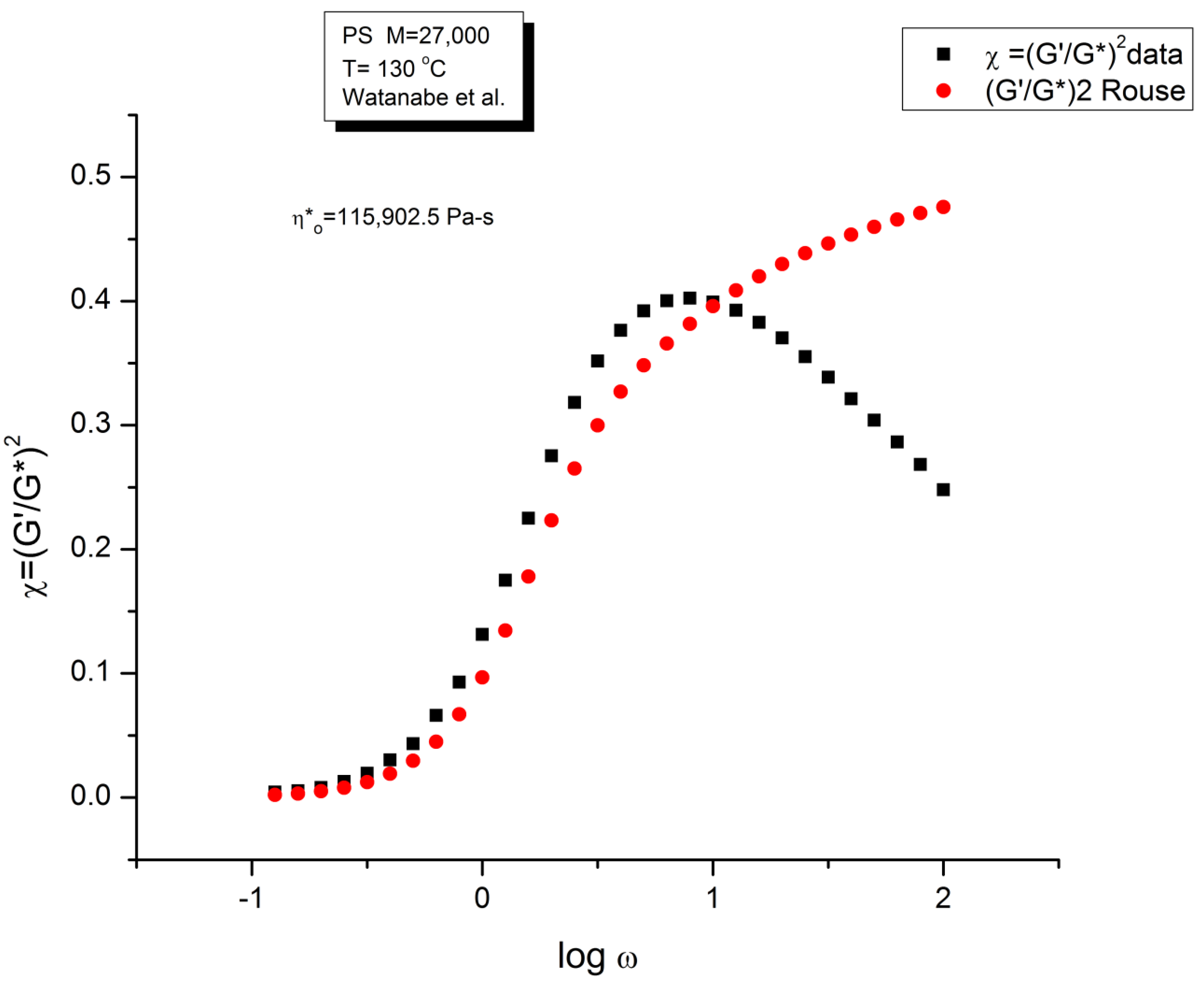
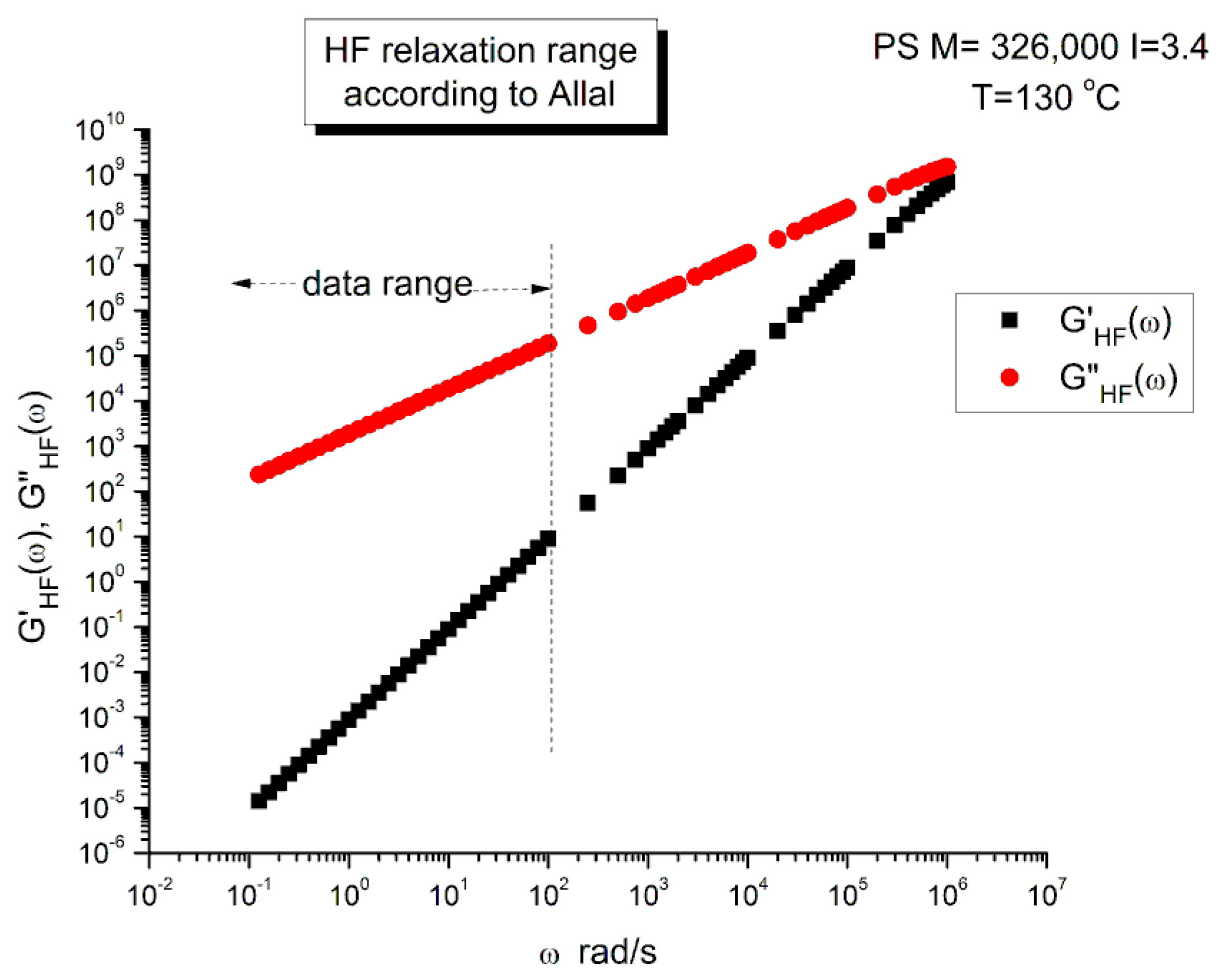
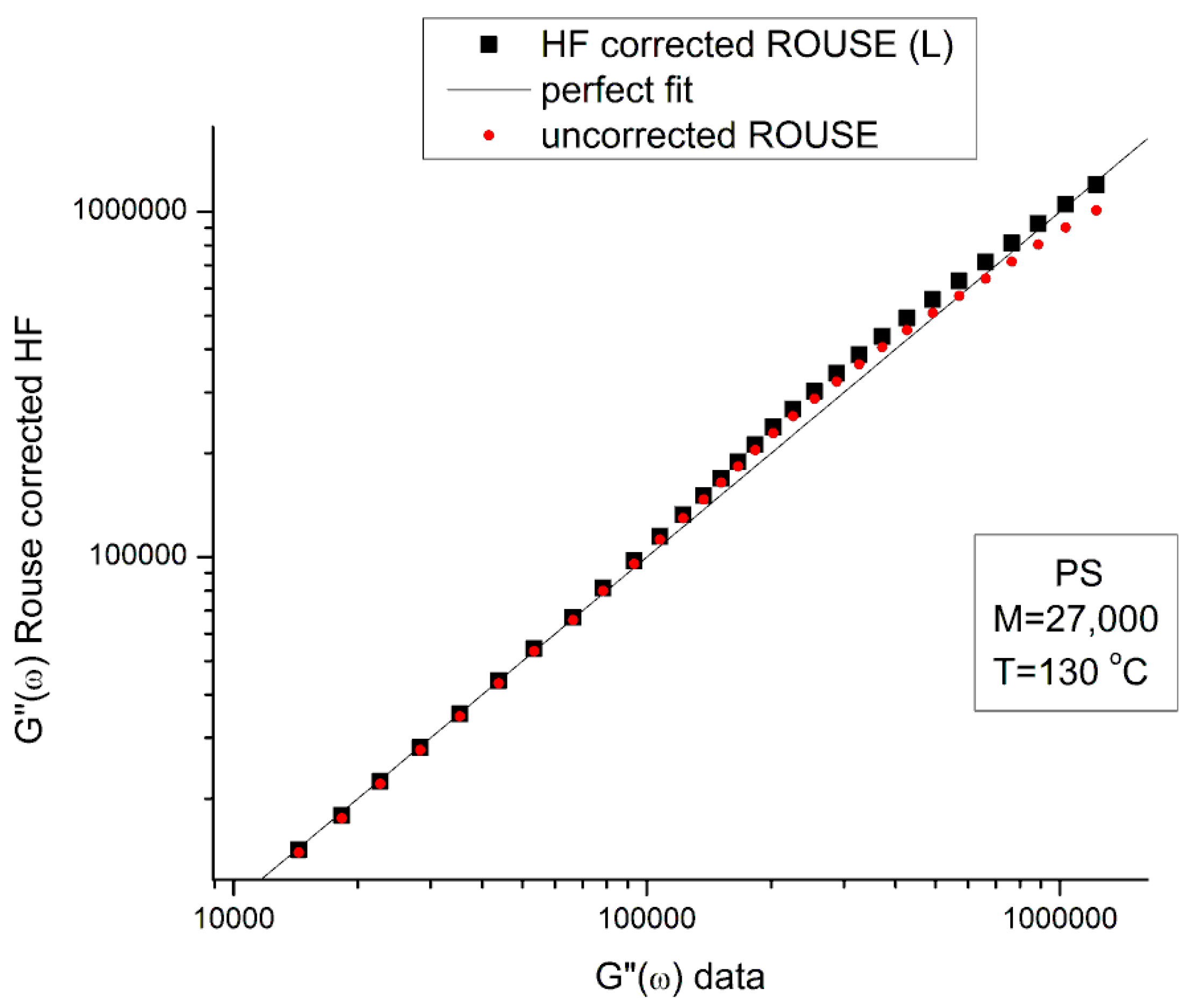
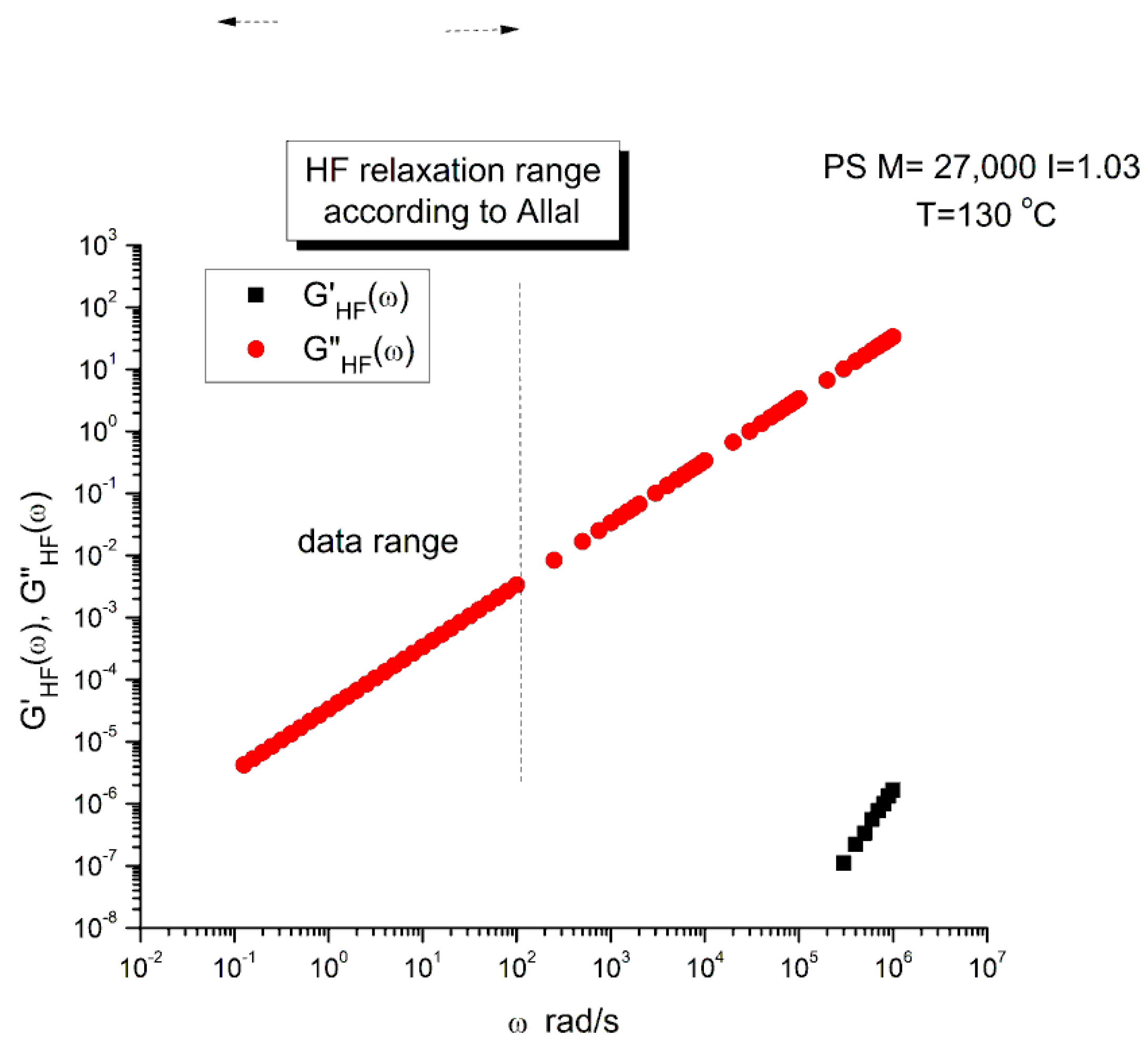
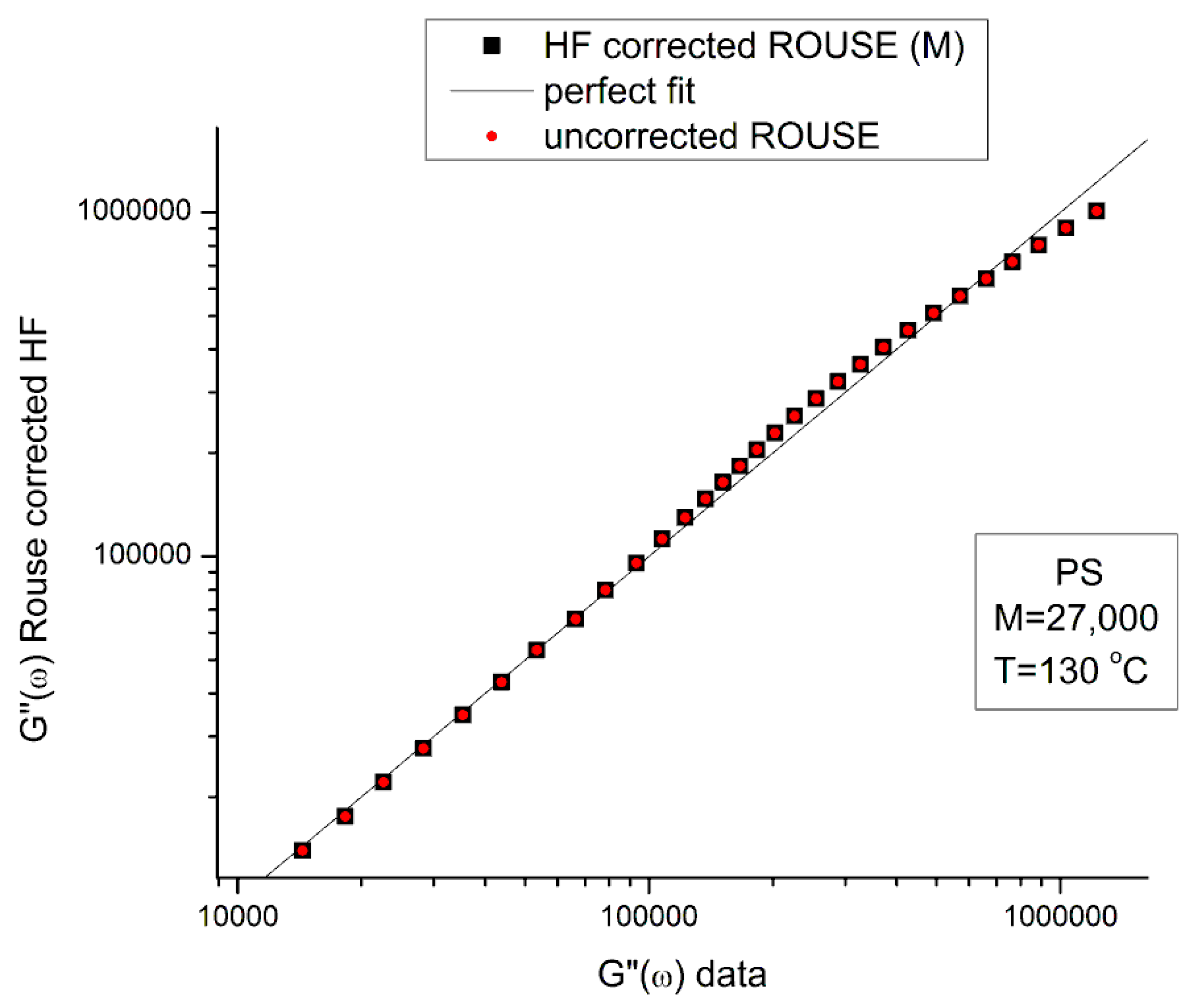
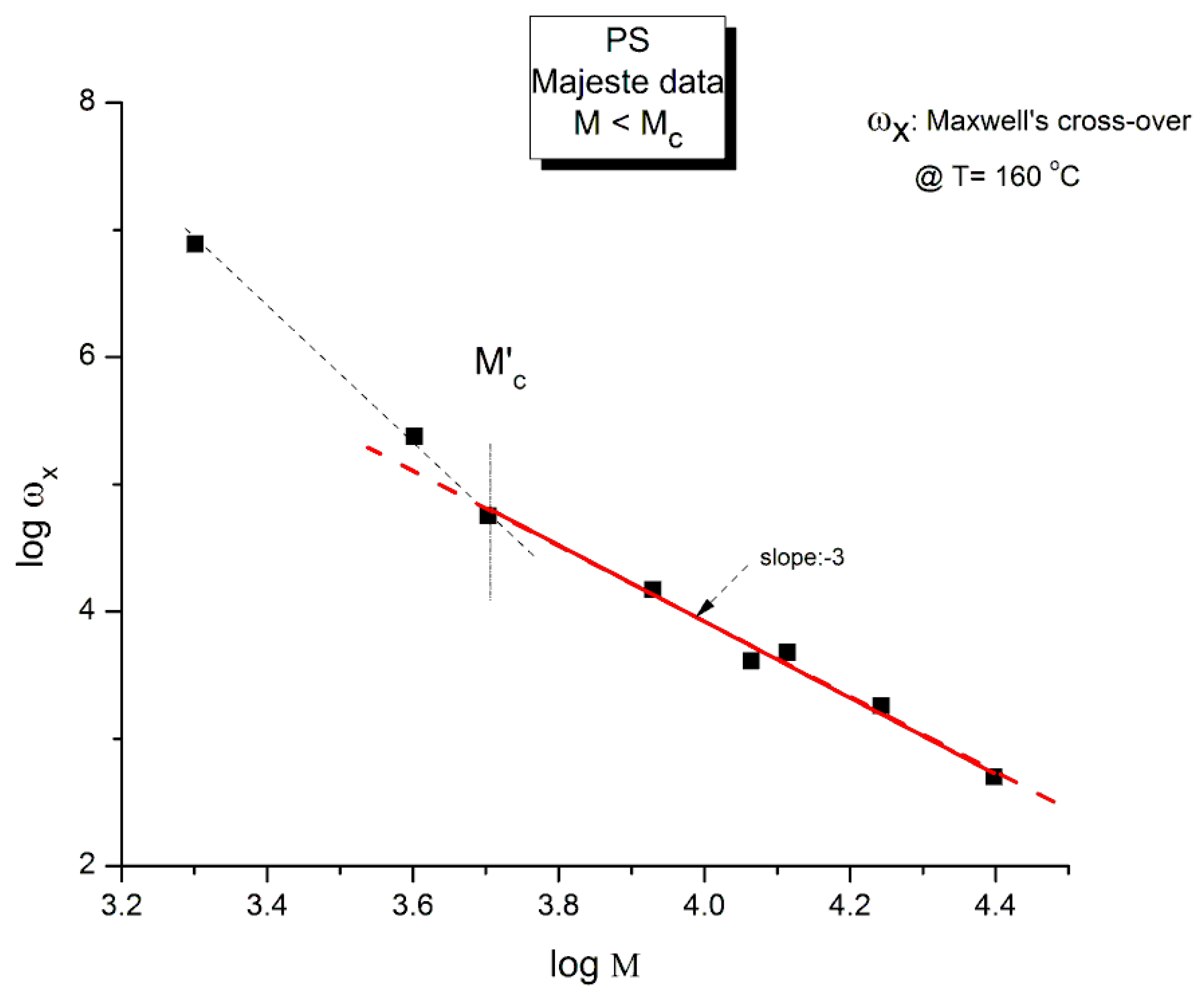
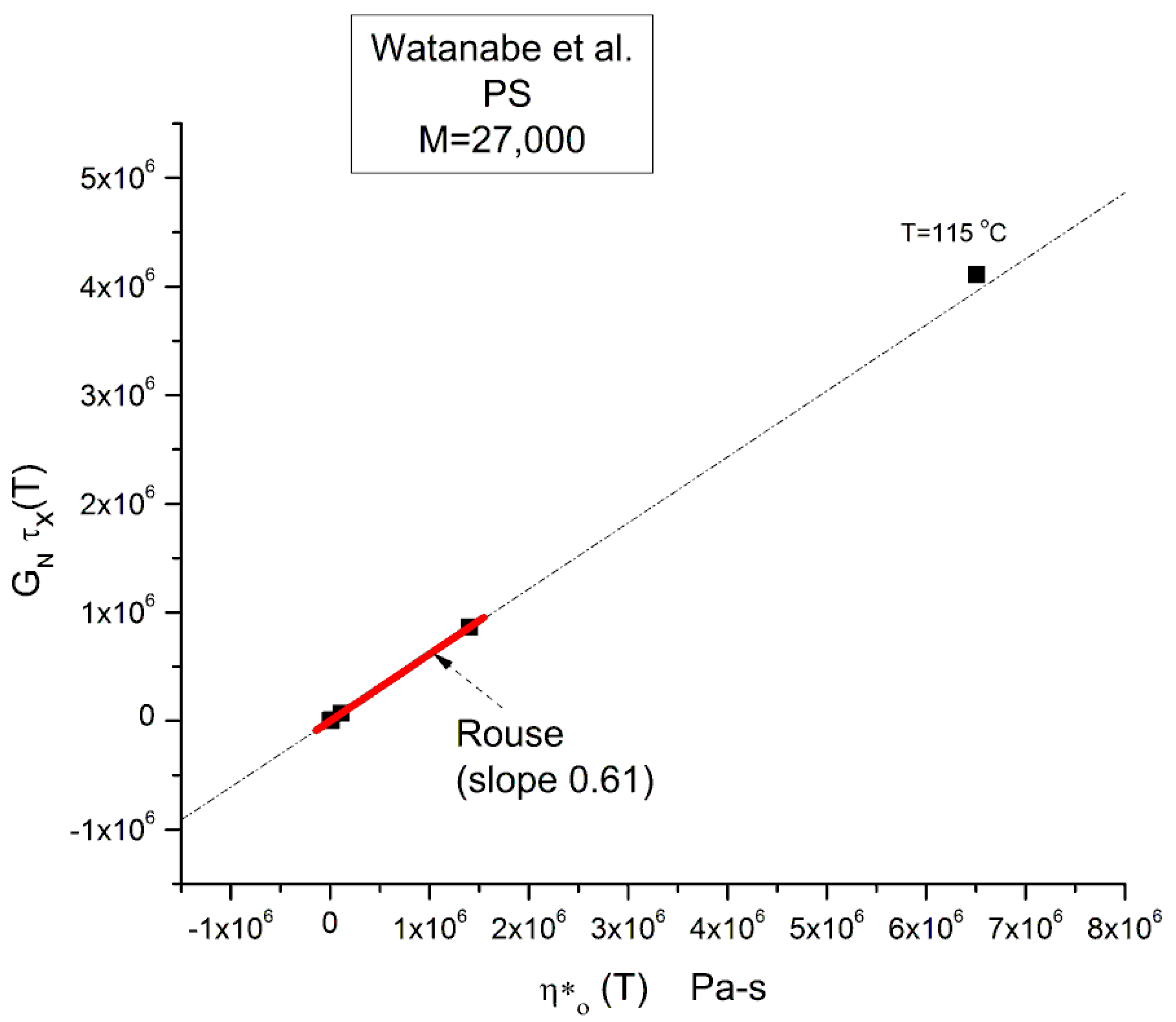


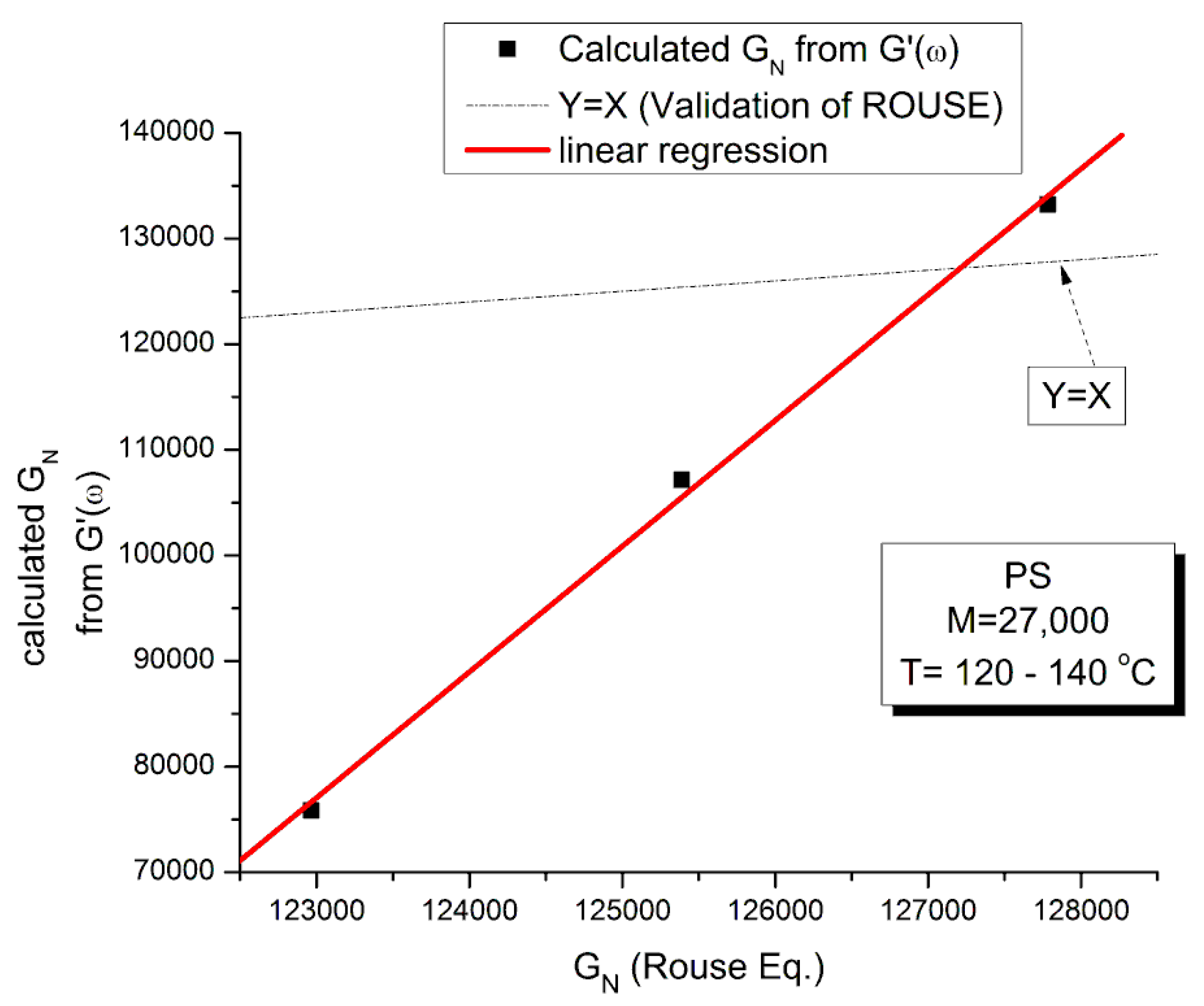


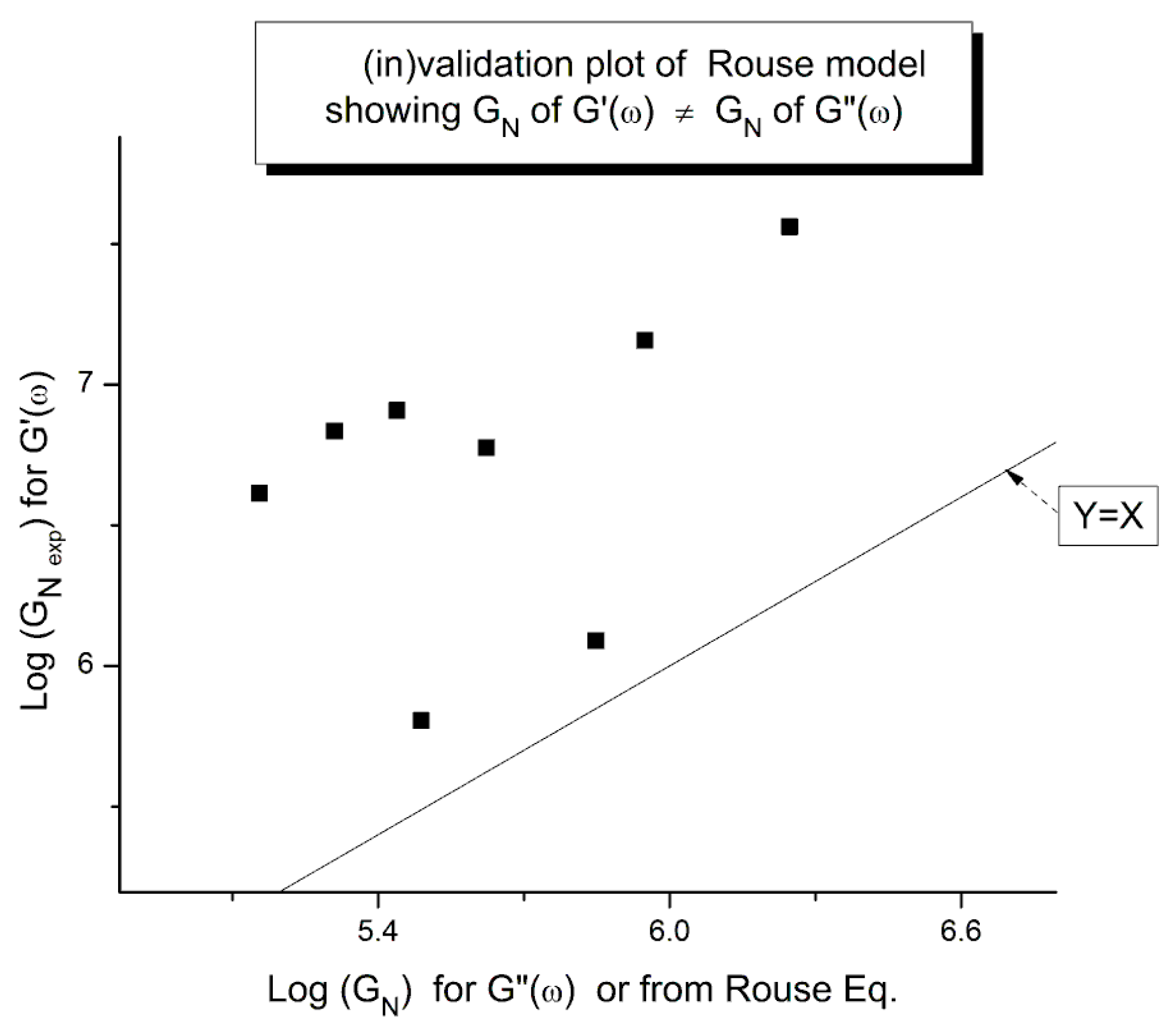
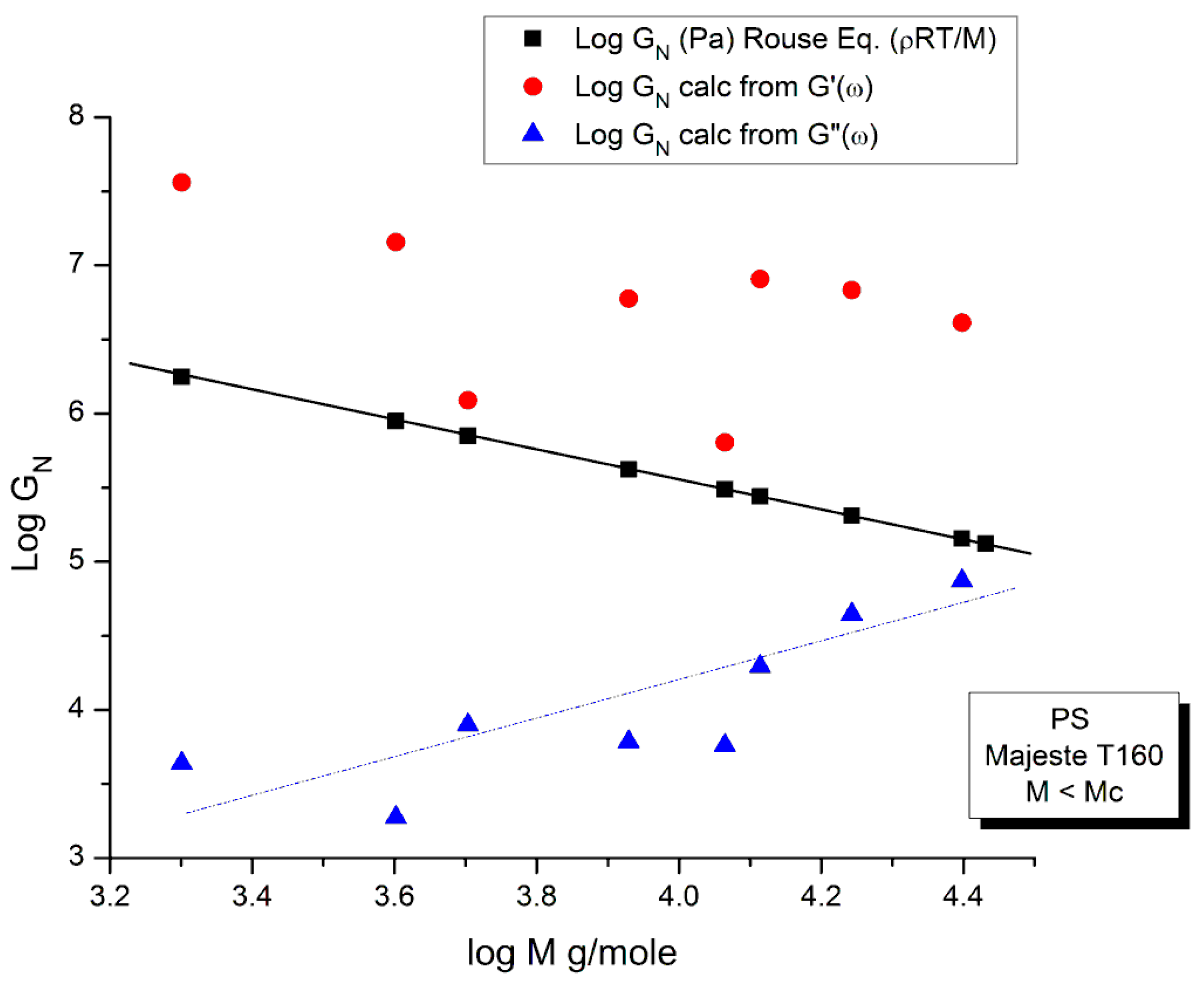
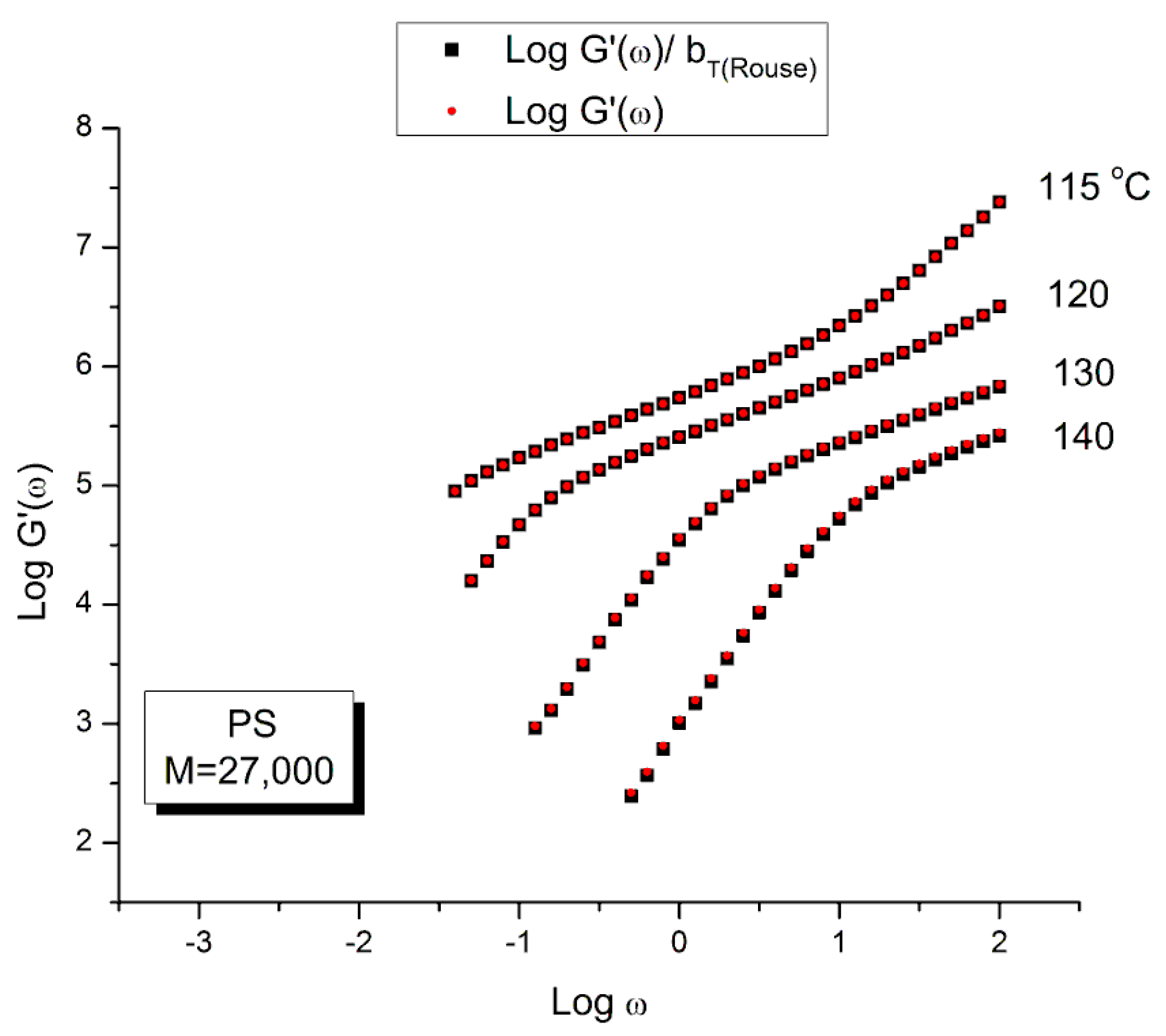
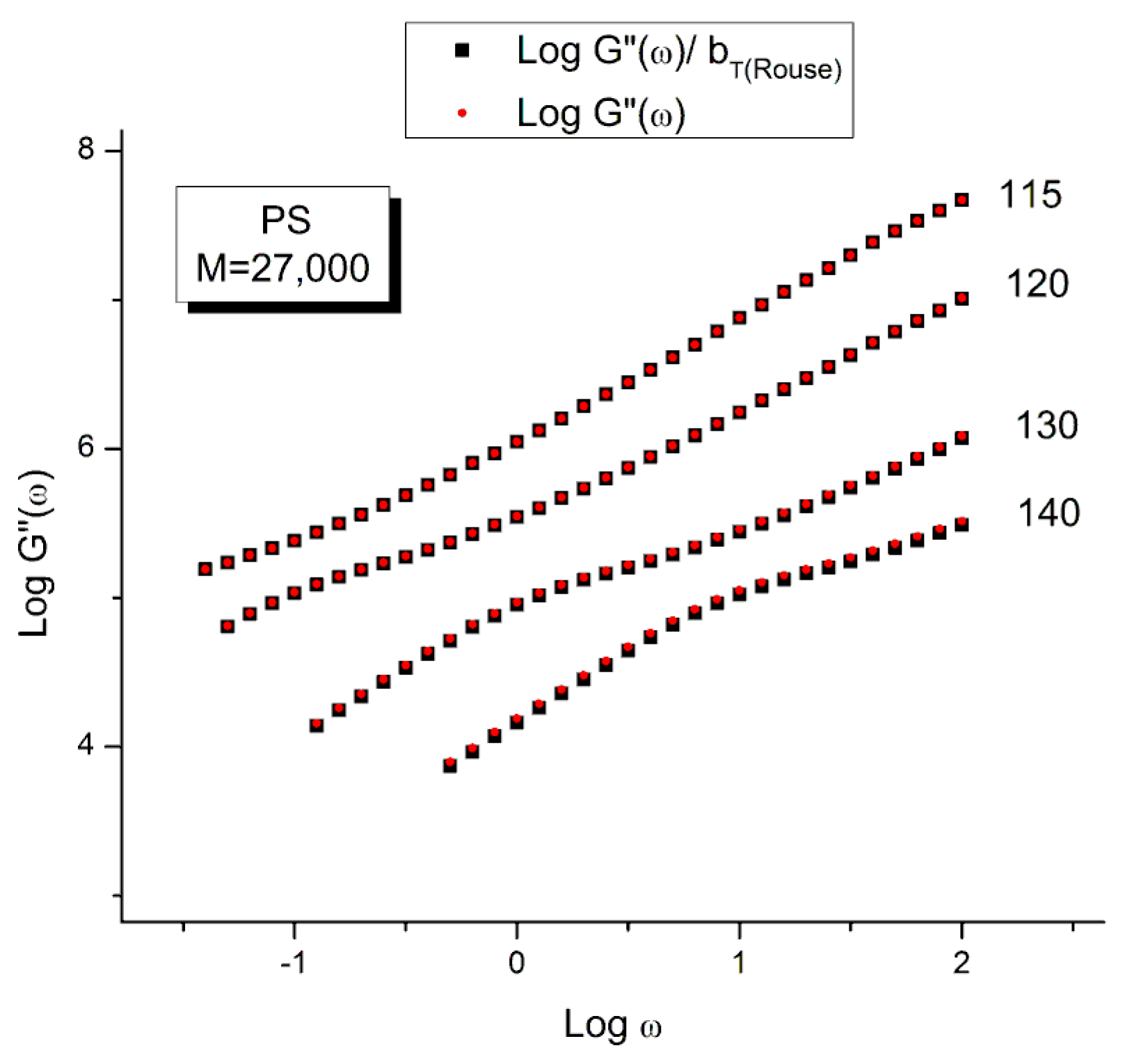
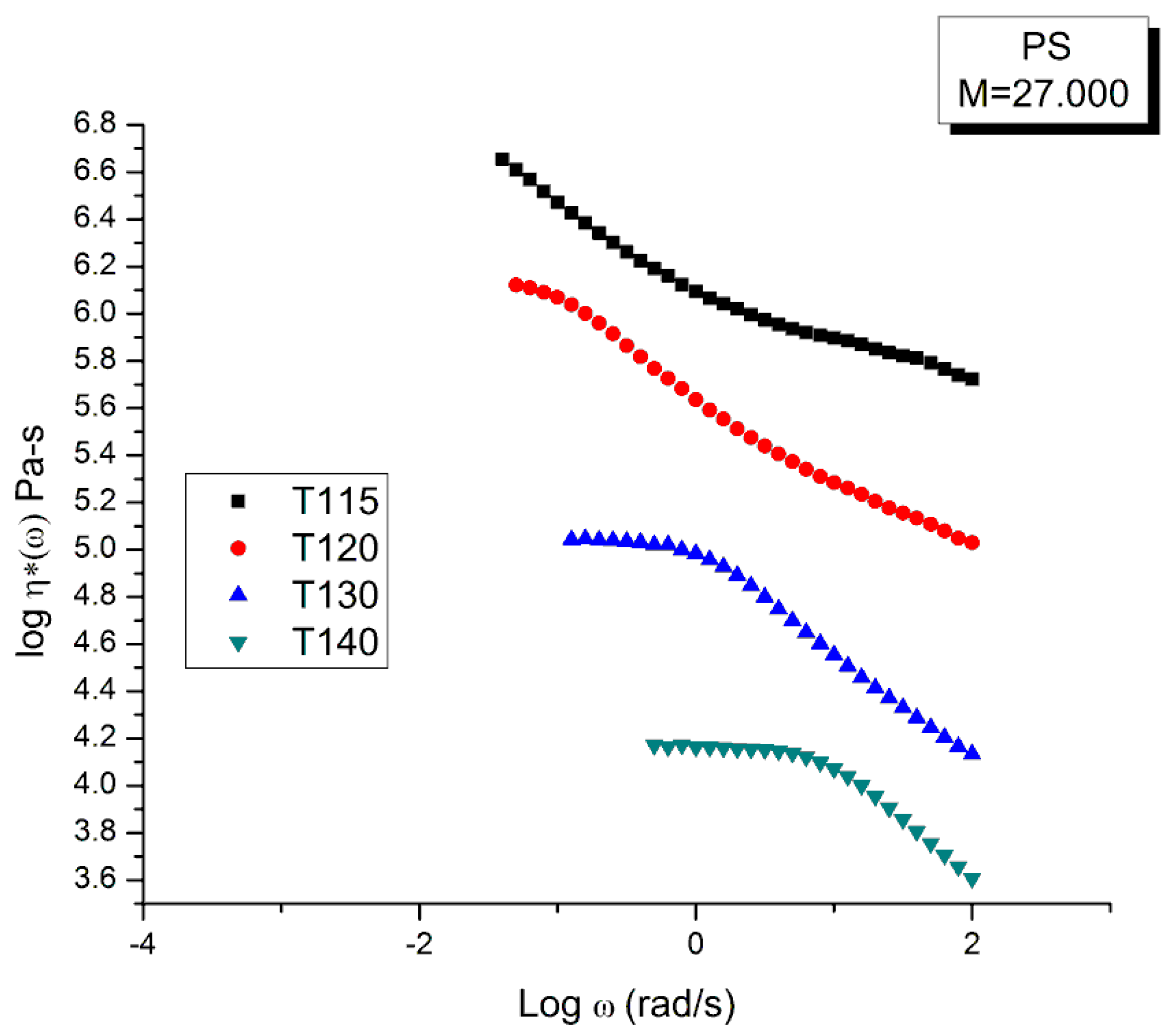
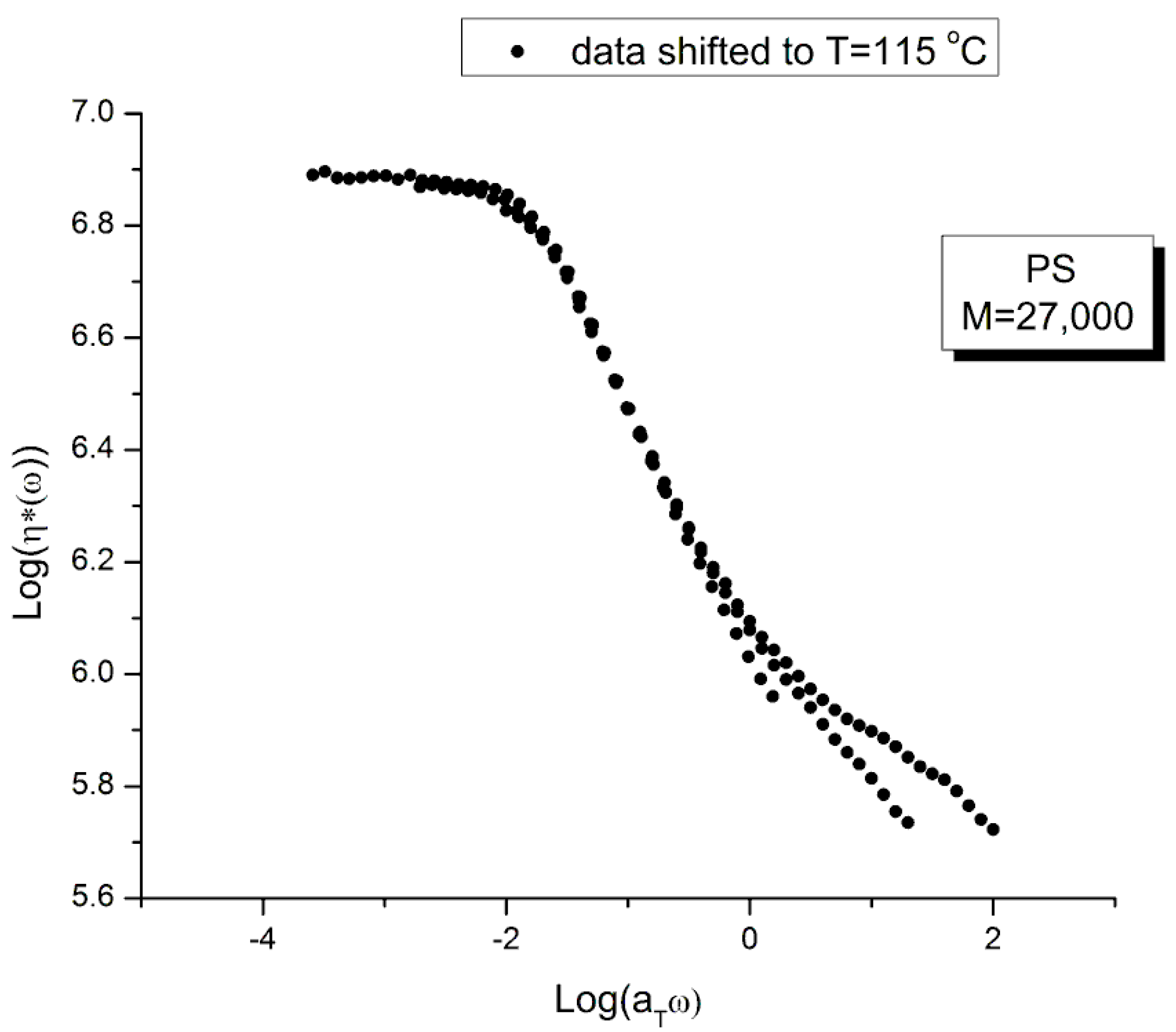
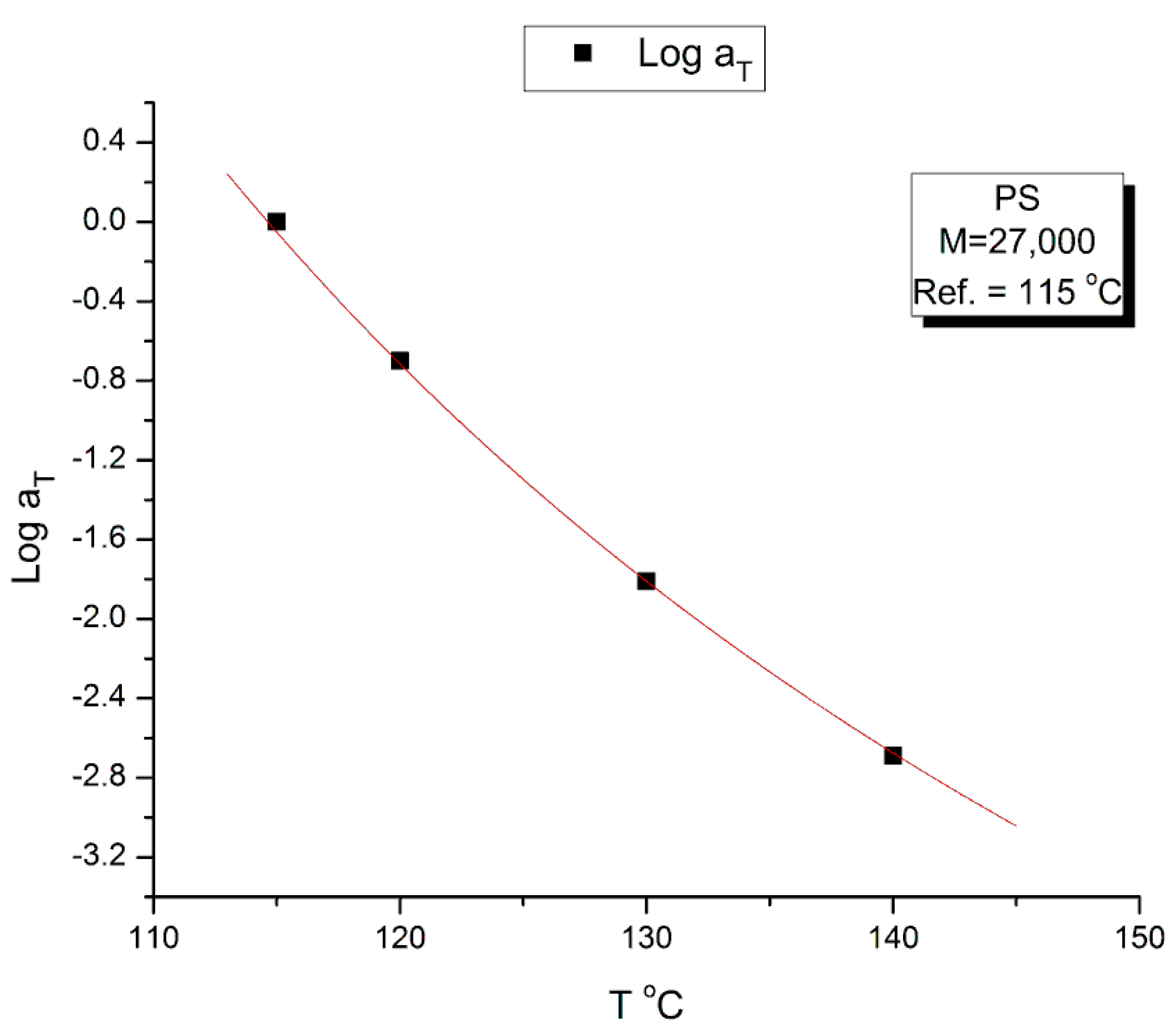
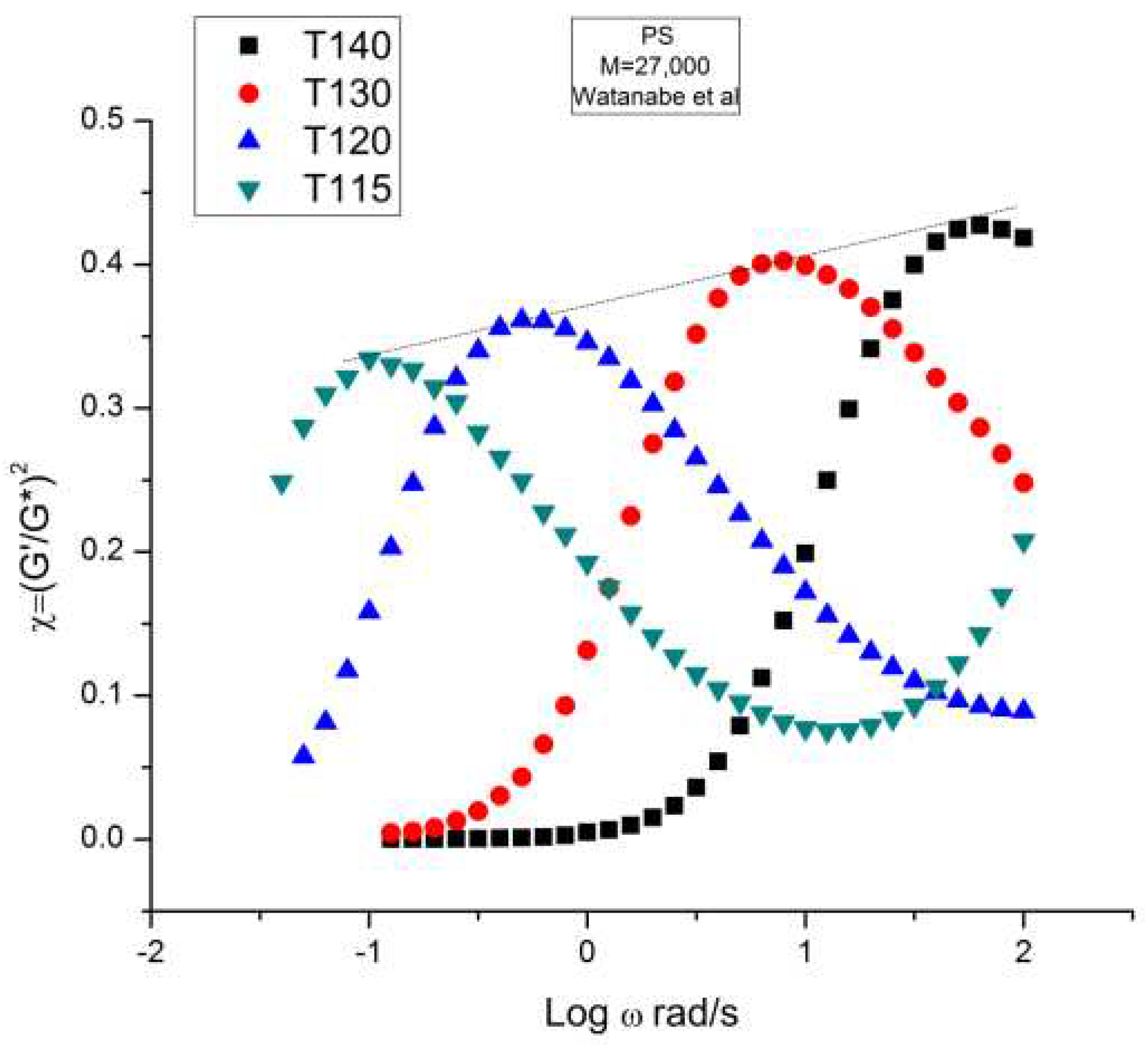
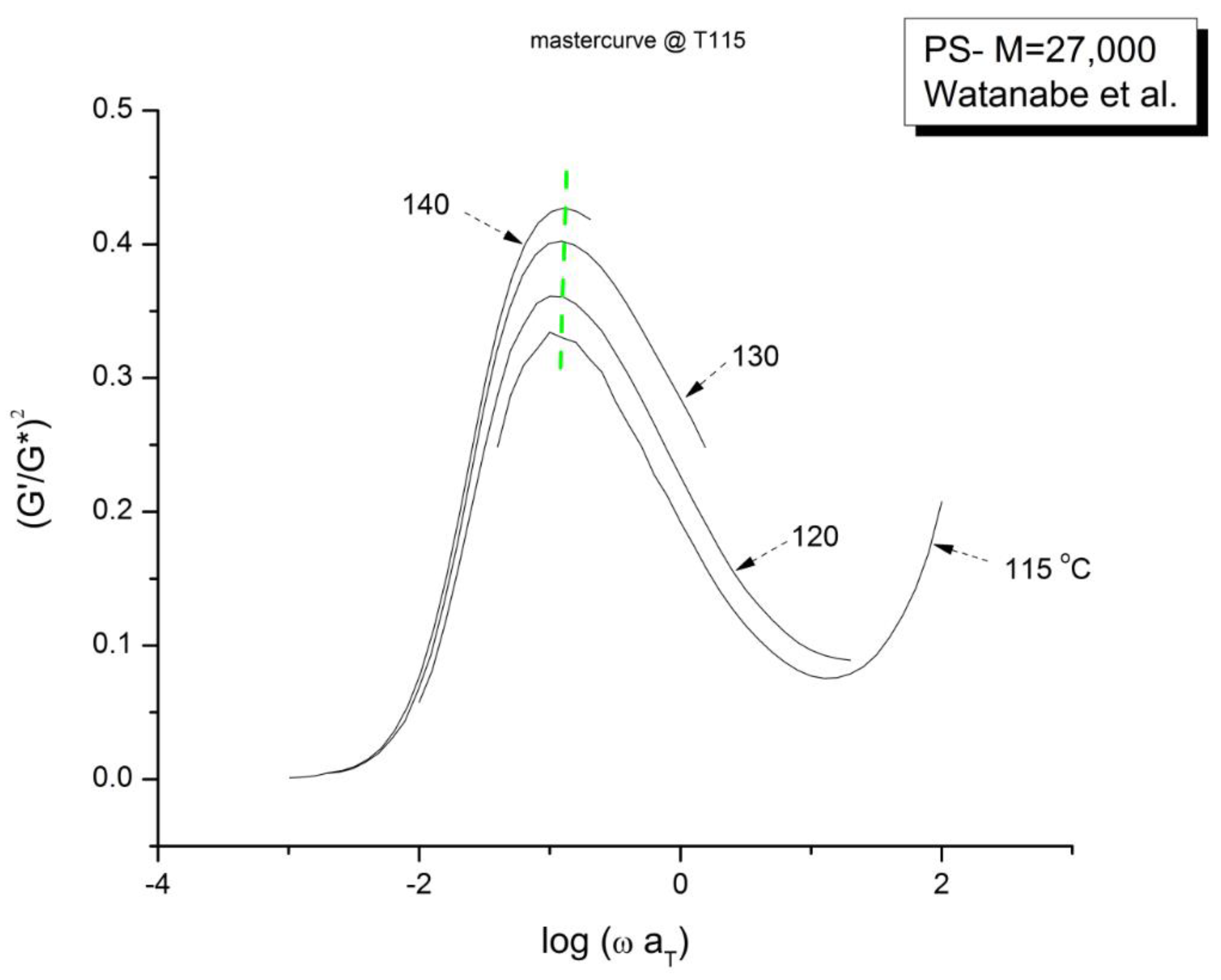


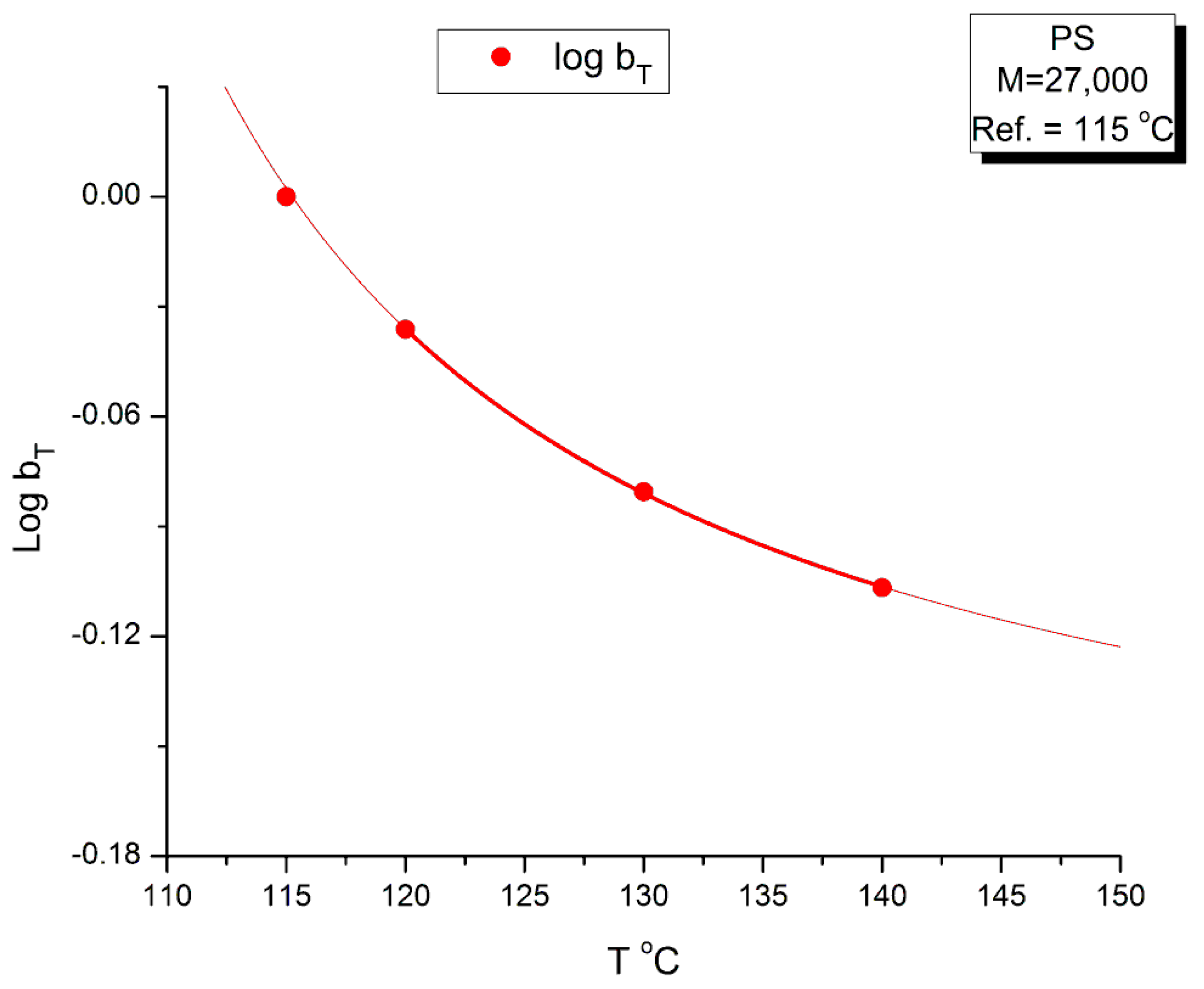
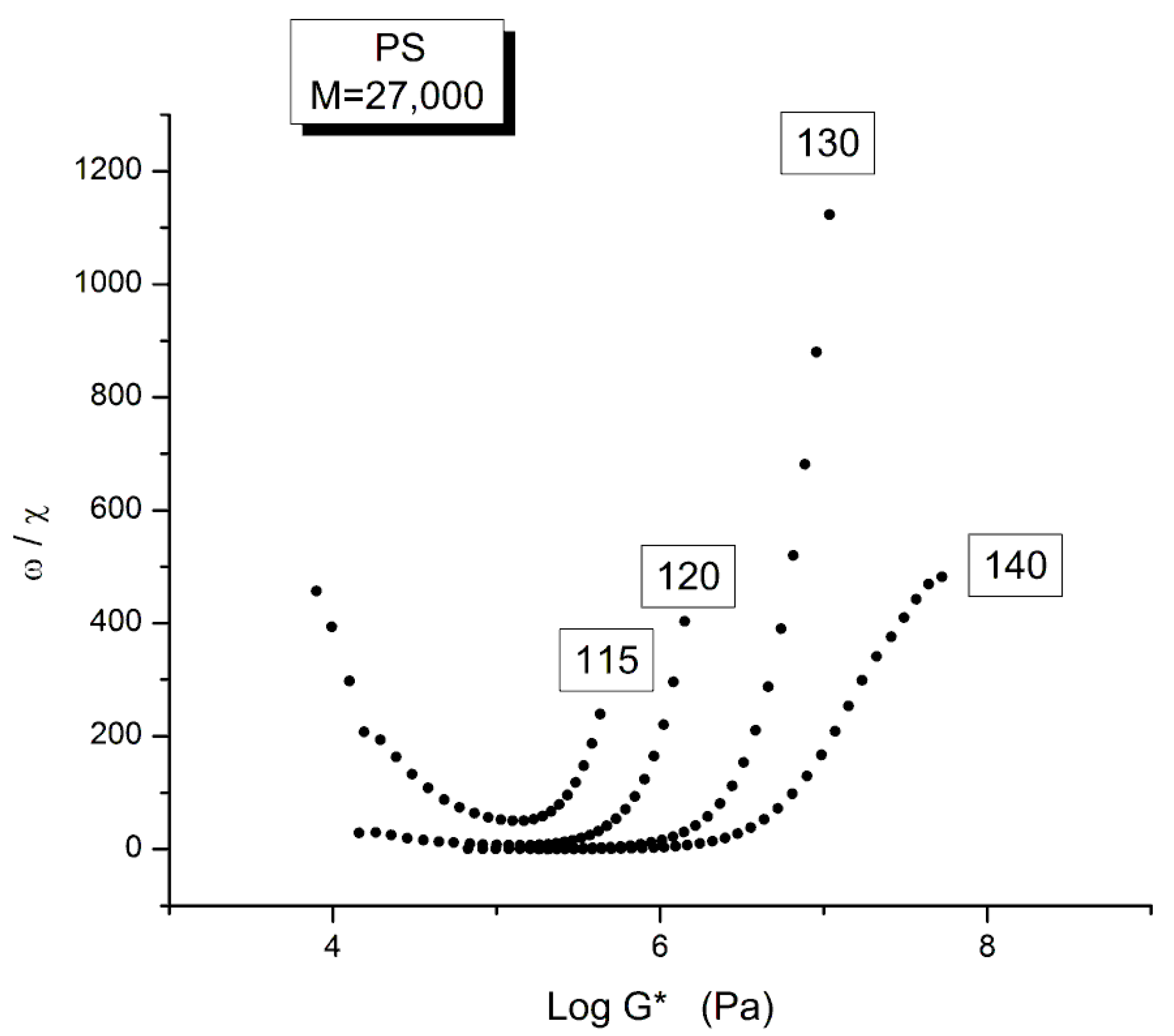
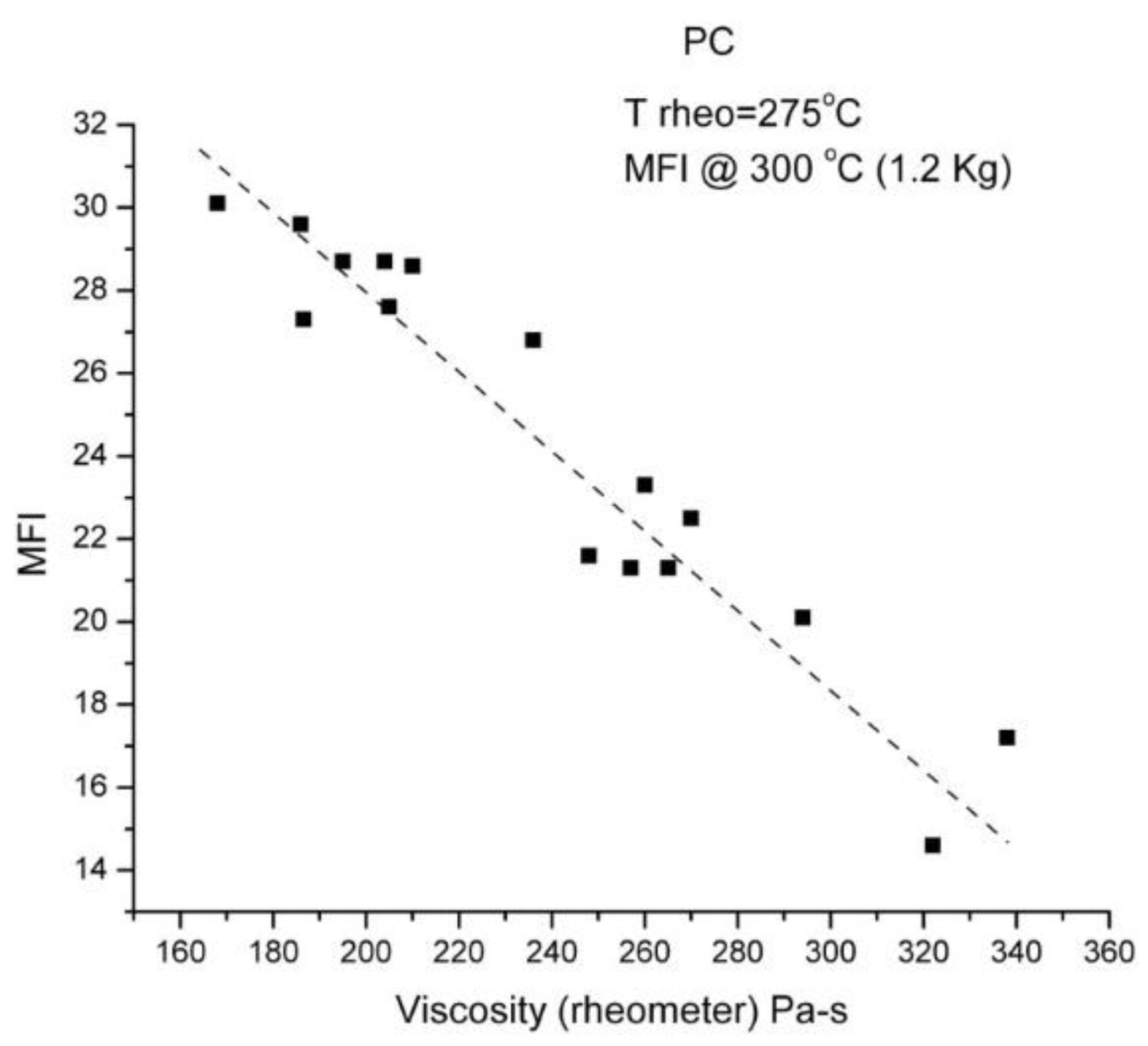
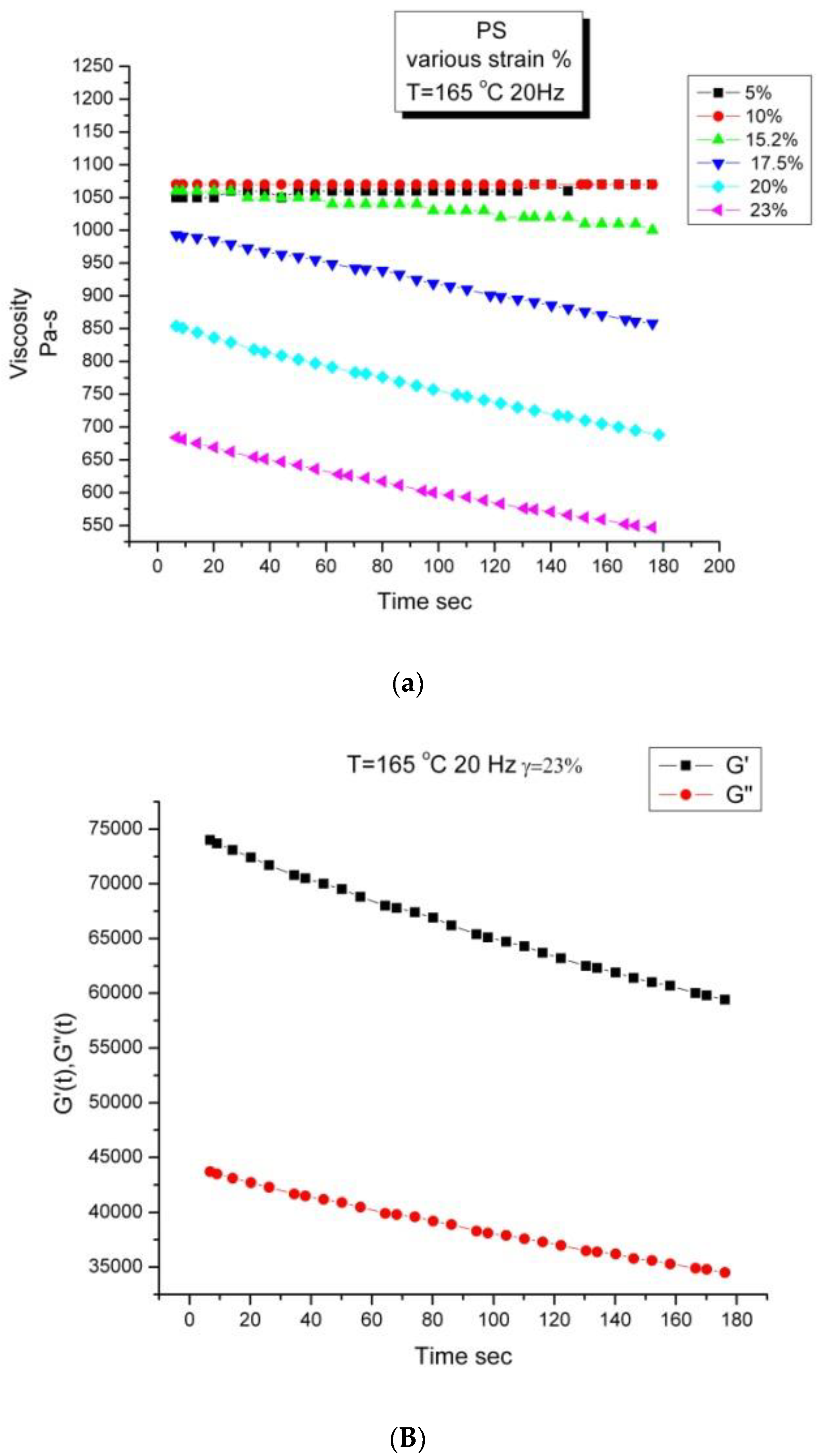
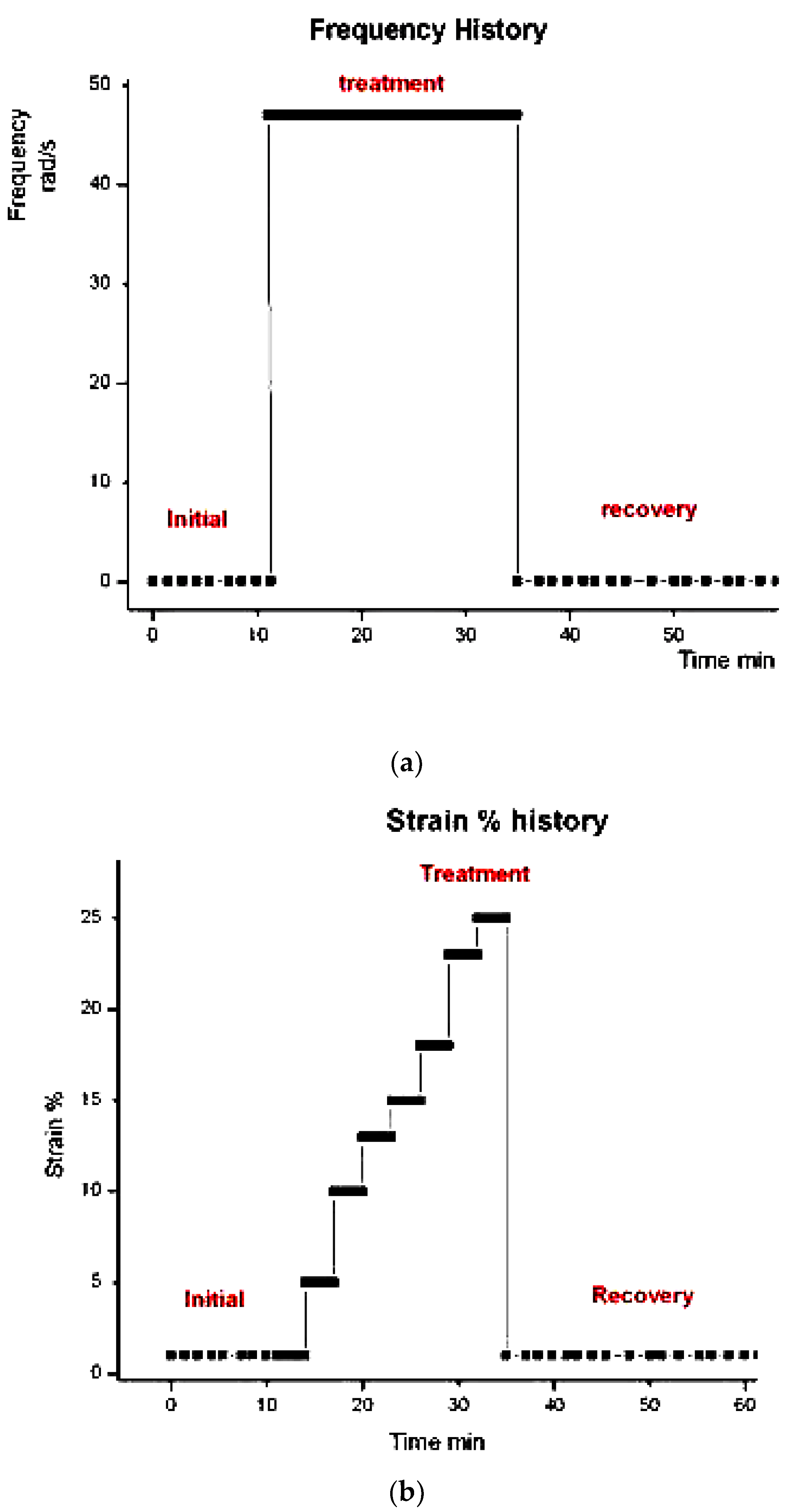
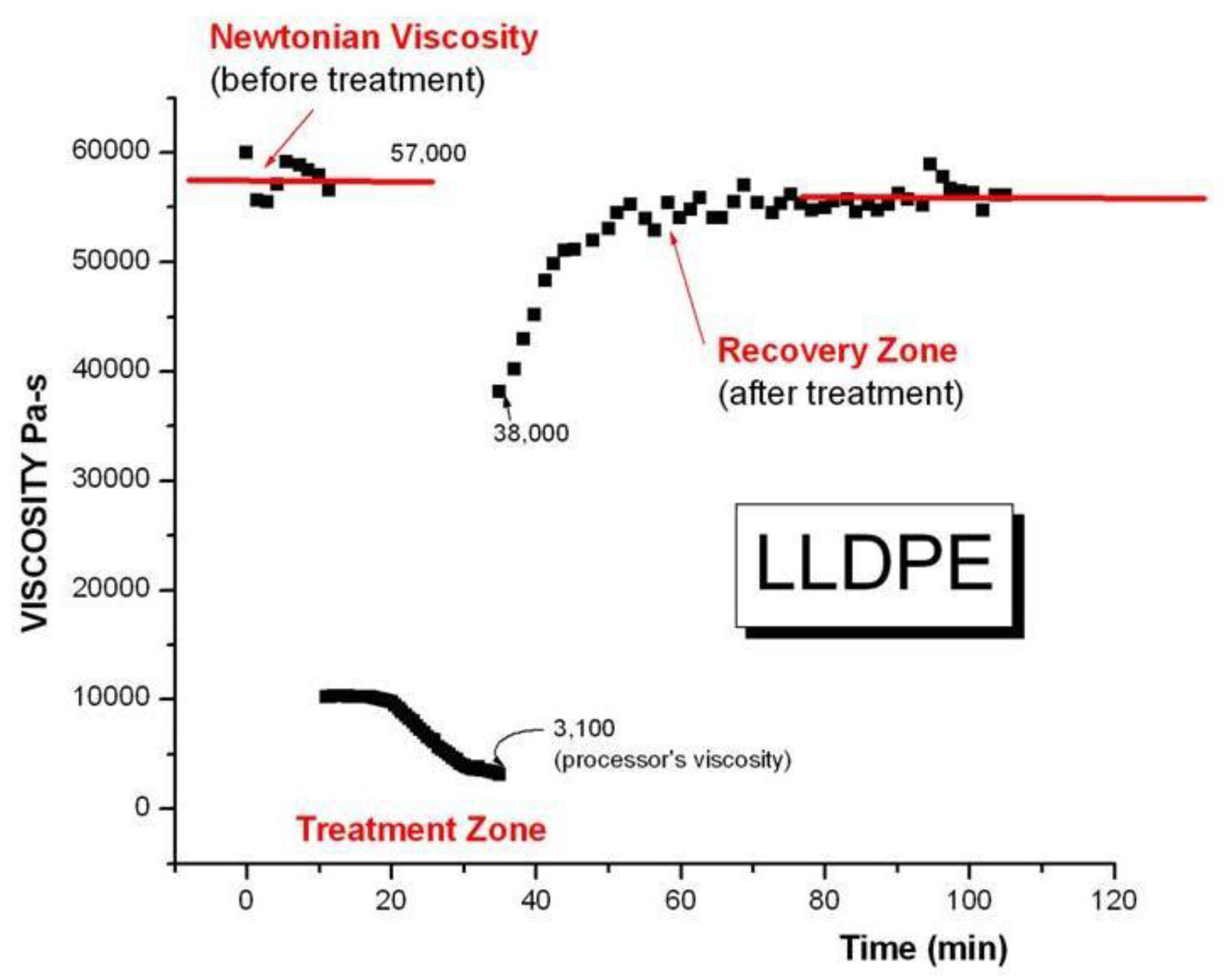
 |
 |
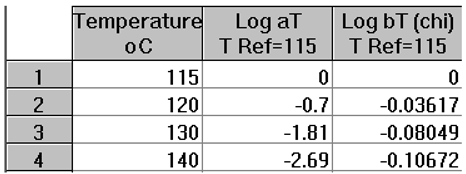 |
Disclaimer/Publisher’s Note: The statements, opinions and data contained in all publications are solely those of the individual author(s) and contributor(s) and not of MDPI and/or the editor(s). MDPI and/or the editor(s) disclaim responsibility for any injury to people or property resulting from any ideas, methods, instructions or products referred to in the content. |
© 2023 by the authors. Licensee MDPI, Basel, Switzerland. This article is an open access article distributed under the terms and conditions of the Creative Commons Attribution (CC BY) license (http://creativecommons.org/licenses/by/4.0/).




